Allison Collection Photos
November, 1944
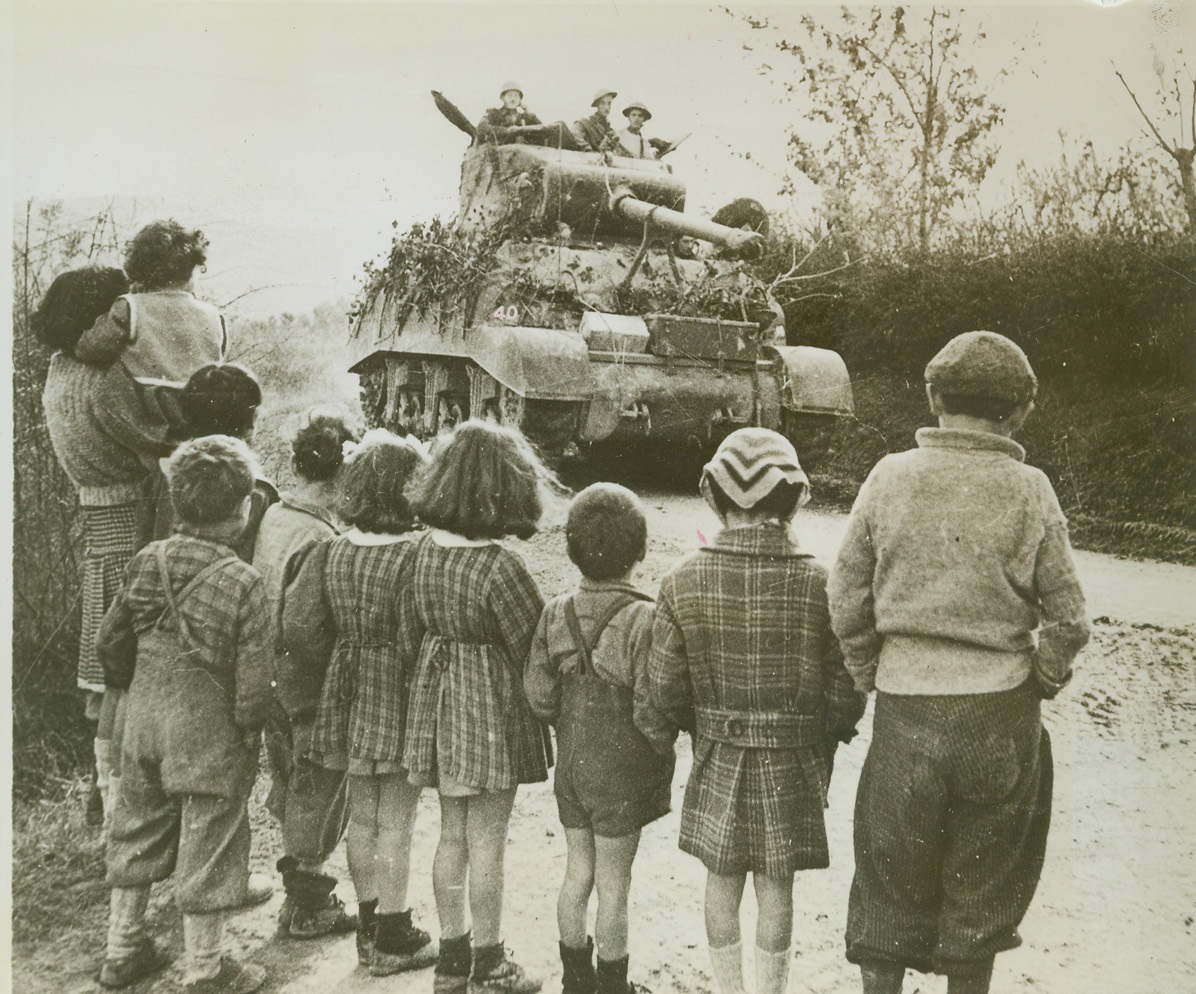
Bred to Warfare, 11/25/1944. Italy – Dressed neatly, a group of Italian children stand on the side of a road, an interested audience as a Sherman tank of the Eighth Army rumbles by. Italy’s new generation, symbolized here, has been bred to the cannon, knowing only the privations of warfare under Fascist rule. The ponderous tank, a tool of Mars, in this case is also a symbol of liberation. As the tank and its crew moves ahead the forces of Democracy and a new way of living moves in on these youngsters. Credit (British Official Photo from ACME);
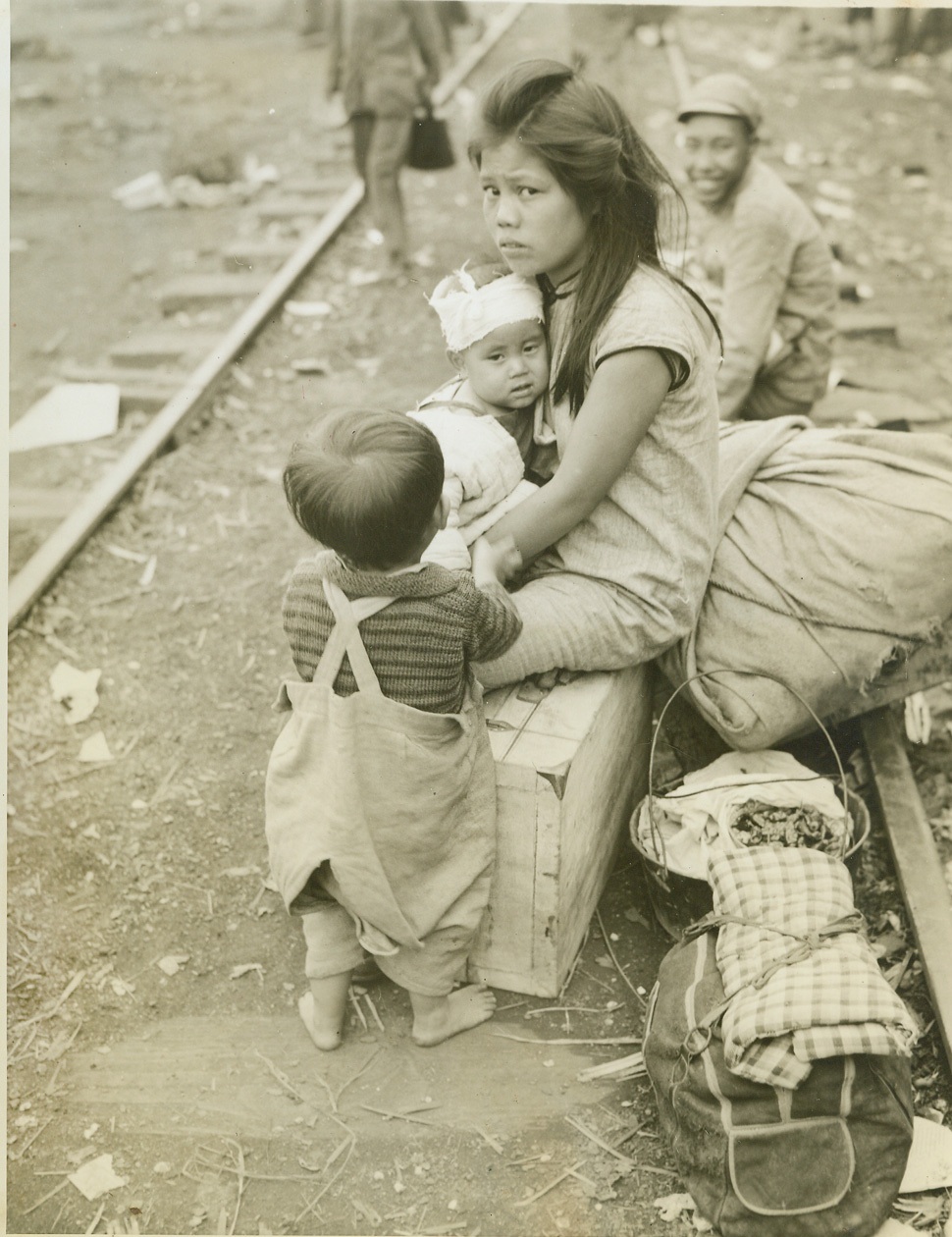
China’s Human Cargo, 11/10/1944. Eastern Front, China – Masses of humanity, united in one common purpose—flight for life—cram the railroads and highways leading from China’s Eastern Front, as the instinct for self-preservation sends them fleeing from Jap terror. Simple peasants they are, familiar with only the ways of simple folk like themselves, but they well know the atrocities of the Japs. Rather than live under the yoke of the Rising Sun, they choose to suffer hardship, and even death, to evade them. Trains leaving Liuchow are packed from the rails to the tops of the cars, and all available vehicles fill the highways as shown in this unusual and dramatic series of photos made by Frank Cancellare, ACME photographer for the War Picture Pool. On the heels of the evacuees follow constantly the fear of the dread typhus and cholera epidemics, but still they go onward. New York Bureau These refugees who were trying to escape on foot, pause by the railroad track to rest for a while. They hold the slim hope that a train may pass on which they can secure a little room. The young child has his head bandaged. Medical authorities along the way care for the refugees. Photo by ACME photographer, Frank Cancellare, for the War Picture Pool. Credit –WP-(ACME);
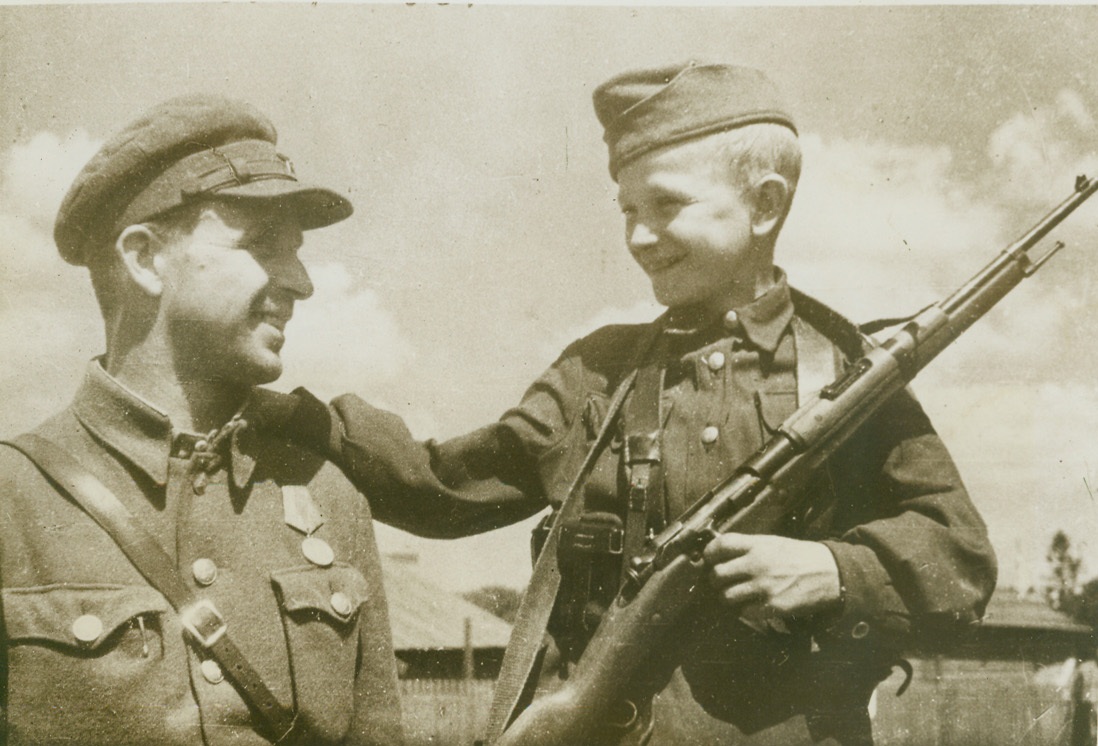
FATHER AND SON FIGHT TOGETHER, 11/22/1944. VILEIKA, U.S.S.R.- A father and son who fight side-by-side with a guerilla band in Russia, A. Volynets and his 13-year-old son, Nikolai, are shown after their recent return to the newly-liberated White Russian town of Vileika. Commander of a guerilla detachment since July, 1941, Volynets considers his young son one of his best scouts. Credit: ACME;
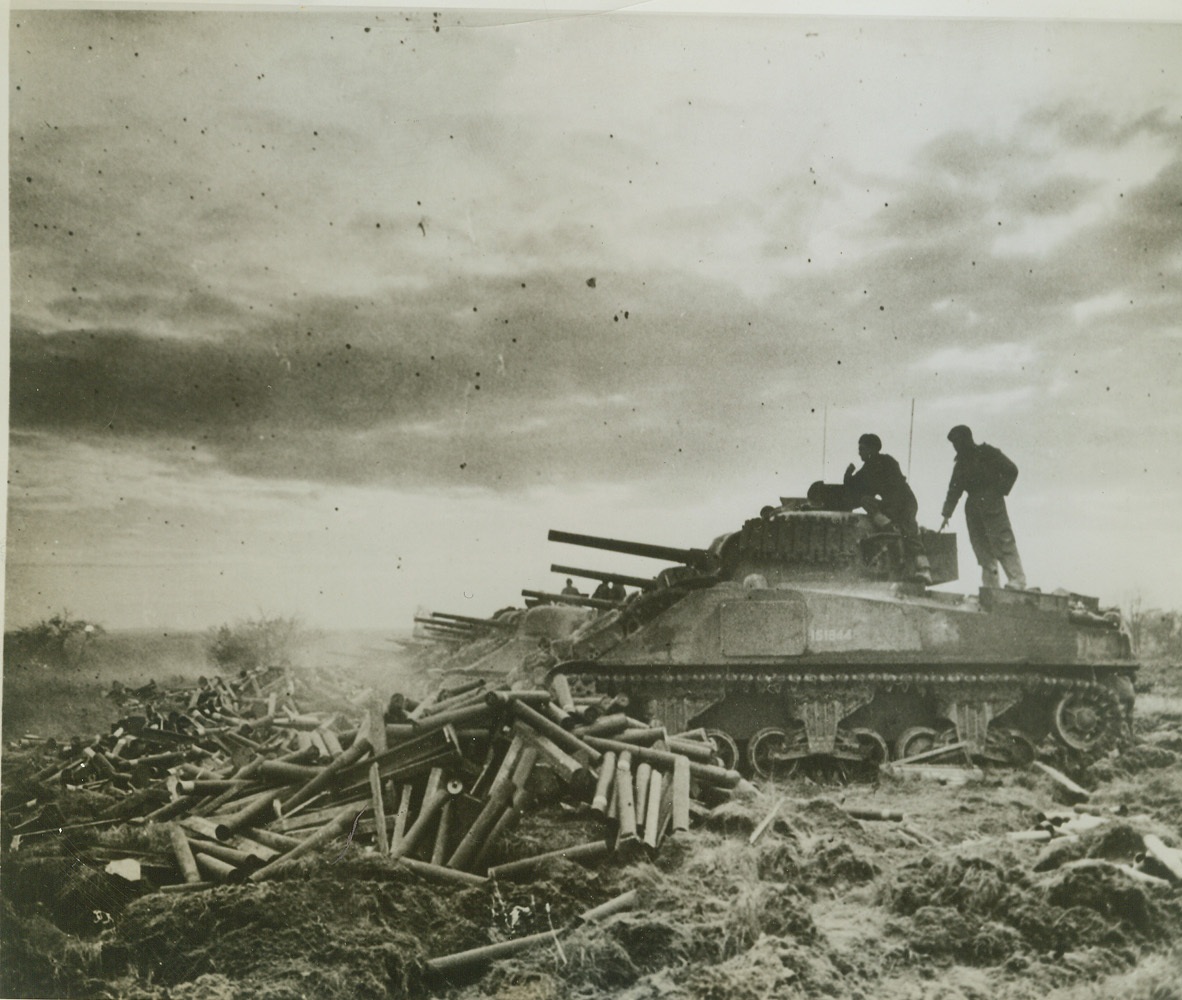
British Tank Battery Assails Germans, 11/26/1944. Germany – Standing behind the turrets for protection, crew members of twelve British tanks fire away at German positions on the road between Gangelt and Geilenkirchen in Germany. In front of the tanks are mounds of empty shells. Credit: (ACME) WP;
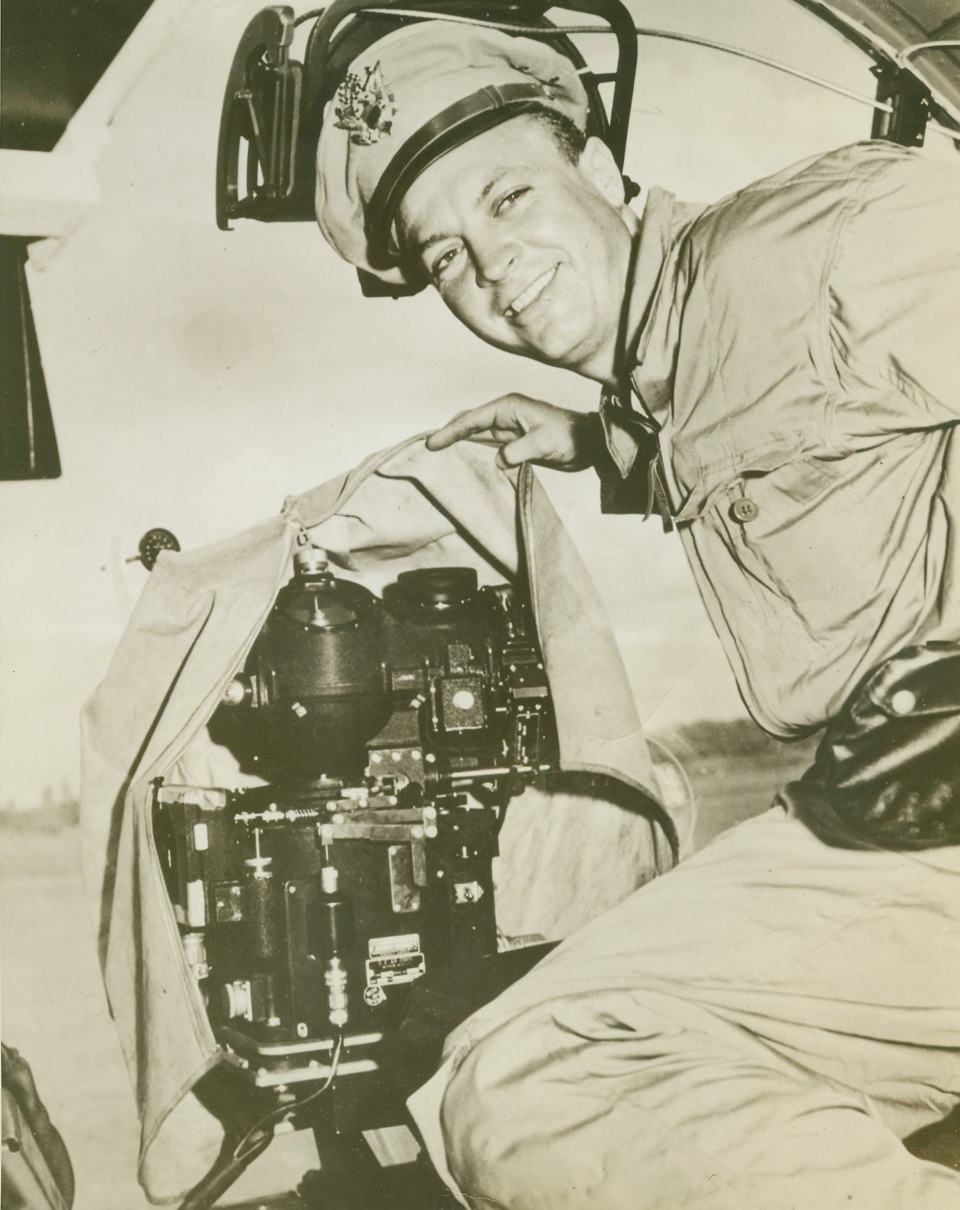
HERE IT IS—THE NORDEN BOMBSIGHT!, 11/23/1944. ORLANDO, FLA.—The cover of secrecy is lifted, at long last, from the Norden bombsight—America’s unparalleled aerial weapon. Now that the bombsight has been captured intact by Germany, it is possible to reveal the closely guarded instrument. It will take years for the Nazis to reproduce the valuable instrument. This first photo of the Norden bombsight was made at the Orlando USAAF Tactical Center.Credit: Army Air Forces photo from Acme;
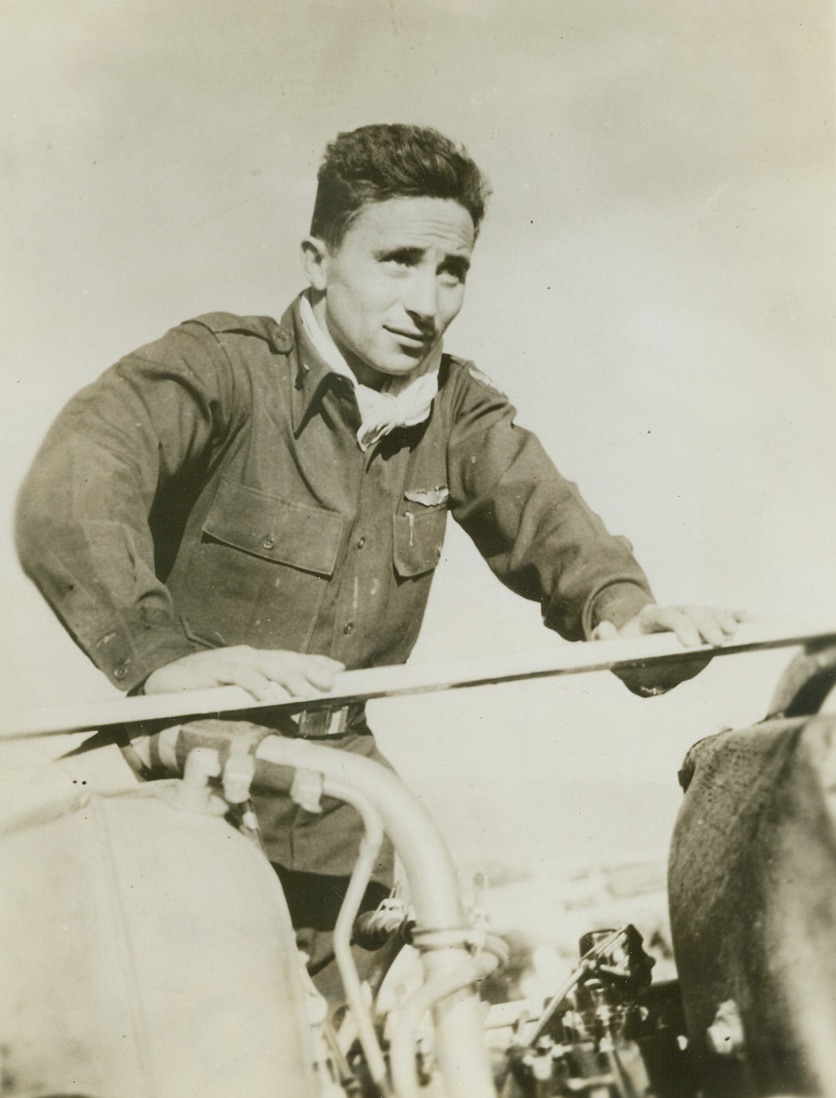
Ace of the Mediterranean, 11/17/1944. Capt. John J. Voll, Goshen, O., recently destroyed four enemy aircraft on a mission over northern Italy to raise his score to 21 planes and make him the leading fighter pilot of the Mediterranean theatre. Capt. Voll was alone over northern Italy at the time, returning early from escorting heavy bombers in a raid on southern Germany because of radio trouble. As he climbed from his mustang back at the base, Capt. Voll wearily remarked, “It was a helluva battle.” Credit: ACME.;
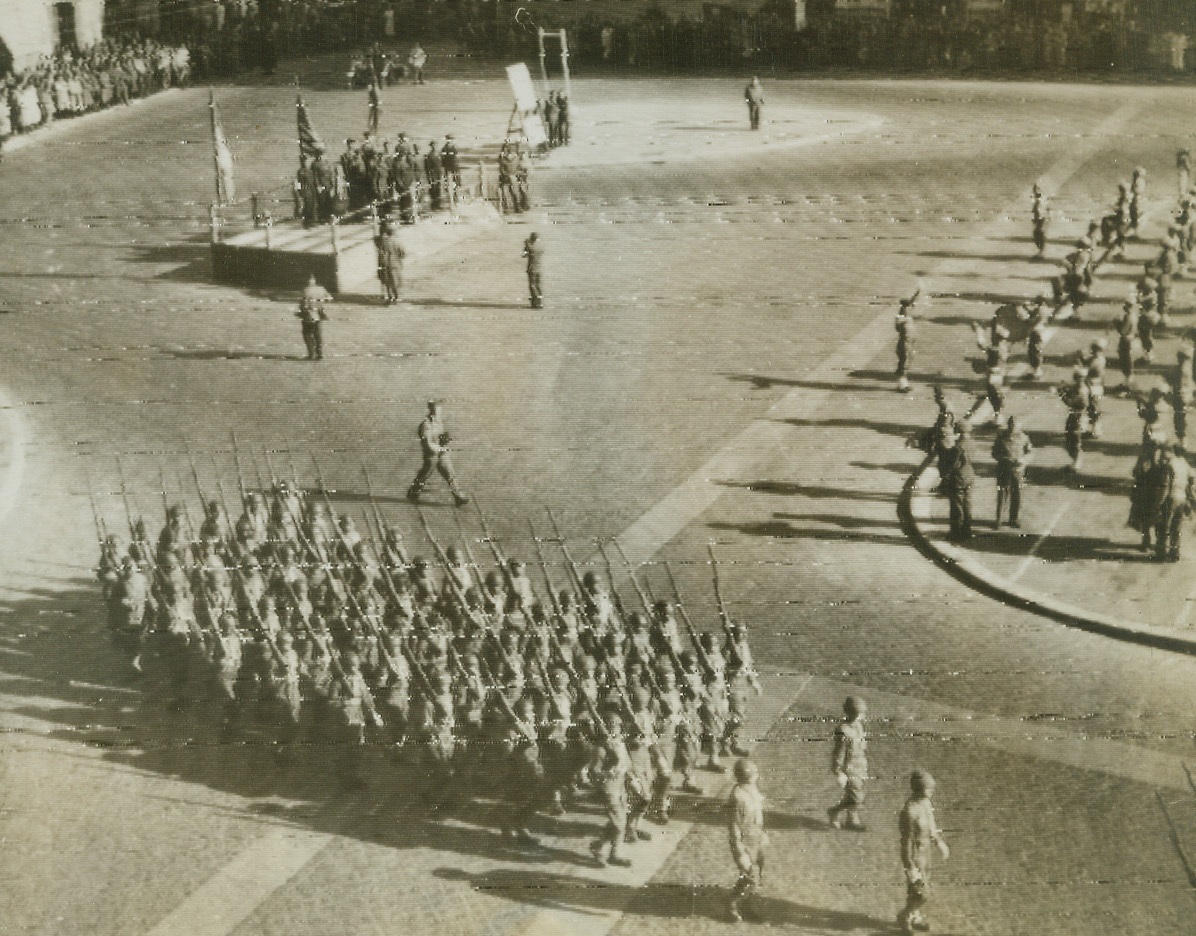
Celebrate Armistice Day in Rome, 11/11/1944. Italy—Marching in cadence Allied armed forces parade in Piazza Venezia, Rome, during ceremonies commemorating the anniversary of Armistice Day. Credit: OWI radiophoto from ACME.;
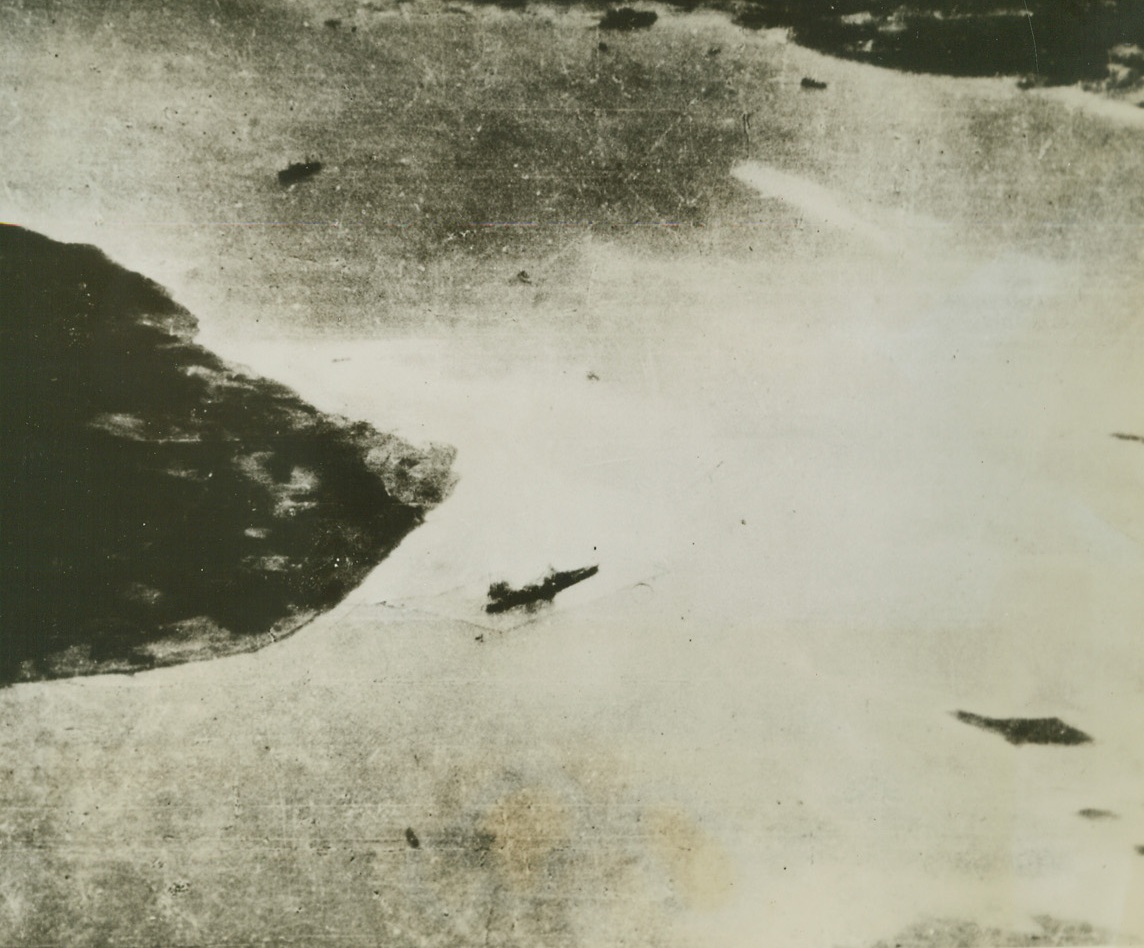
Death of the Tirpitz-#1, 11/17/1944. The German battleship Tirpitz (left center) rides at anchor in Tromso Fjord, Norway, where she was attacked by a force of 32 Lancaster bombers of the RAF on the morning of Sunday, Nov. 12. The 45,000-ton dread-naught is surrounded by an anti-torpedo boom. Credit: British official photo from ACME.;
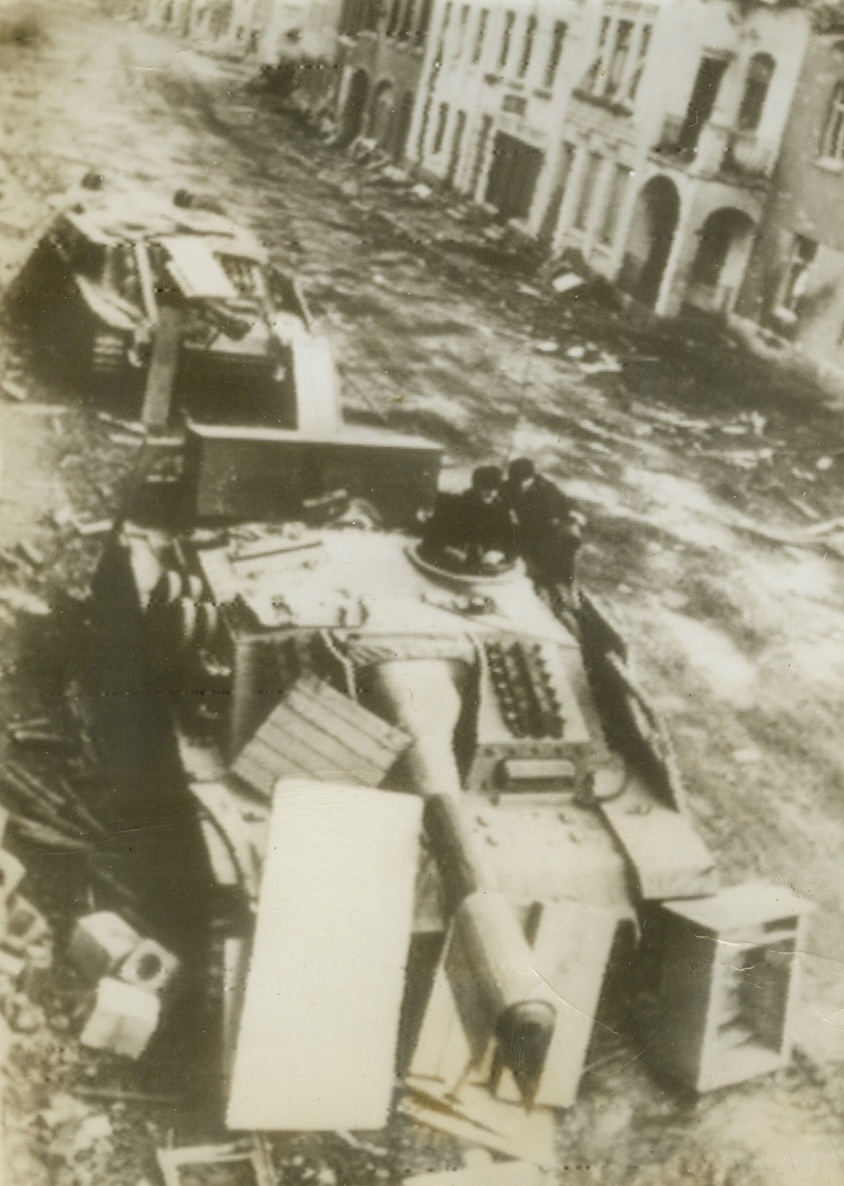
Assault Guns Bark in the Streets, 11/23/1944. WUERSELEN, GERMANY—Ineffectually camouflaged with debris from the shell-wrecked houses in background, two Nazi assault guns fight in the streets of Wuerselen, according to the German caption accompanying this photo. Obtained through a neutral source, photo was radioed to New York on Nov. 23, 1944. Credit: ACME RADIOPHOTO.;
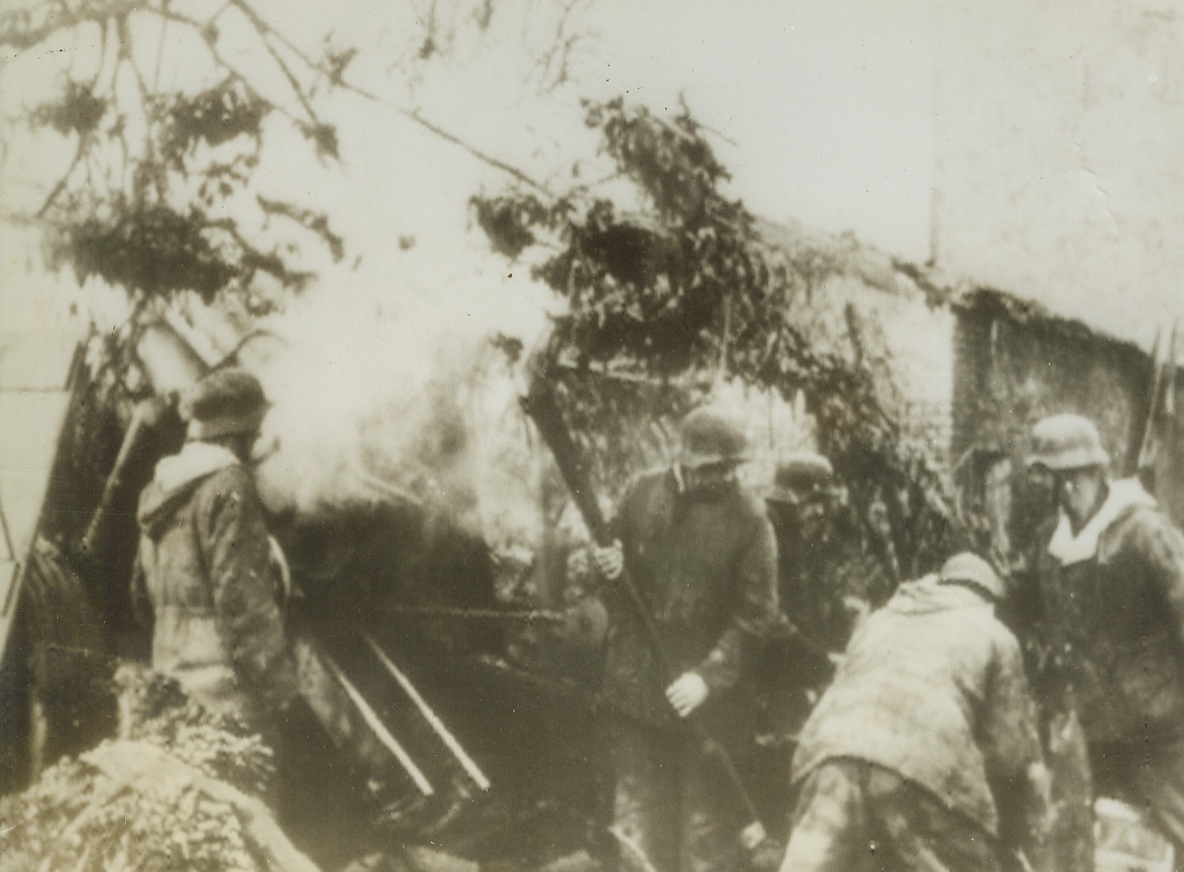
Firing Over Ruined Home, 11/23/1944. WUERSELEN, GERMANY—A camouflaged field howitzer fires over the ruins of houses in Wuerselen, according to the German caption accompanying this photo, which was radioed to New York from Stockholm. Credit: ACME RADIOPHOTO.;
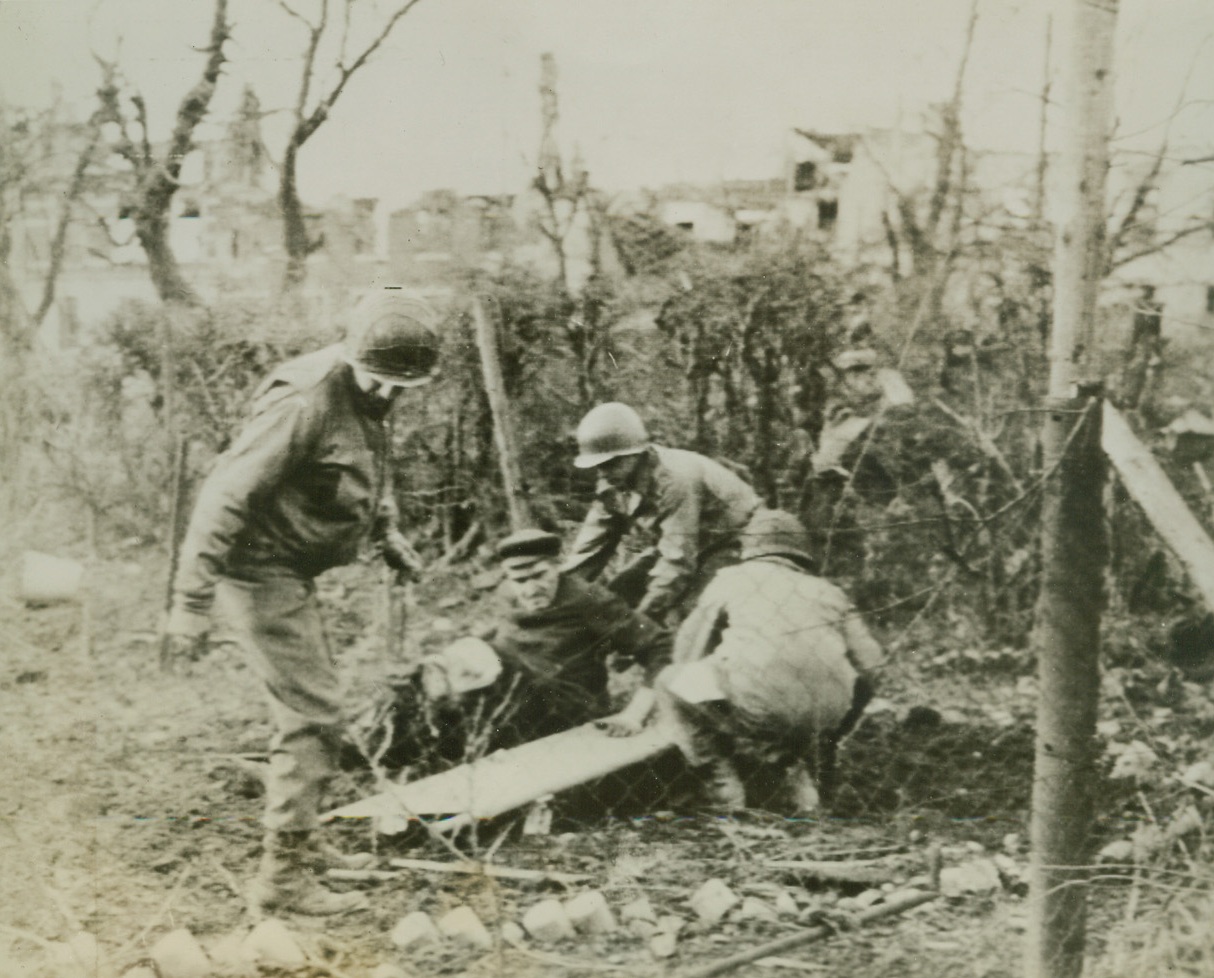
Aid Wounded German Civilian, 11/22/1944. GERMANY – A medical party in Wurselen lifts a wounded German civilian onto a litter. The civilian had just stepped on a Nazi box mine.Credit (Army Radiotelephoto from ACME);
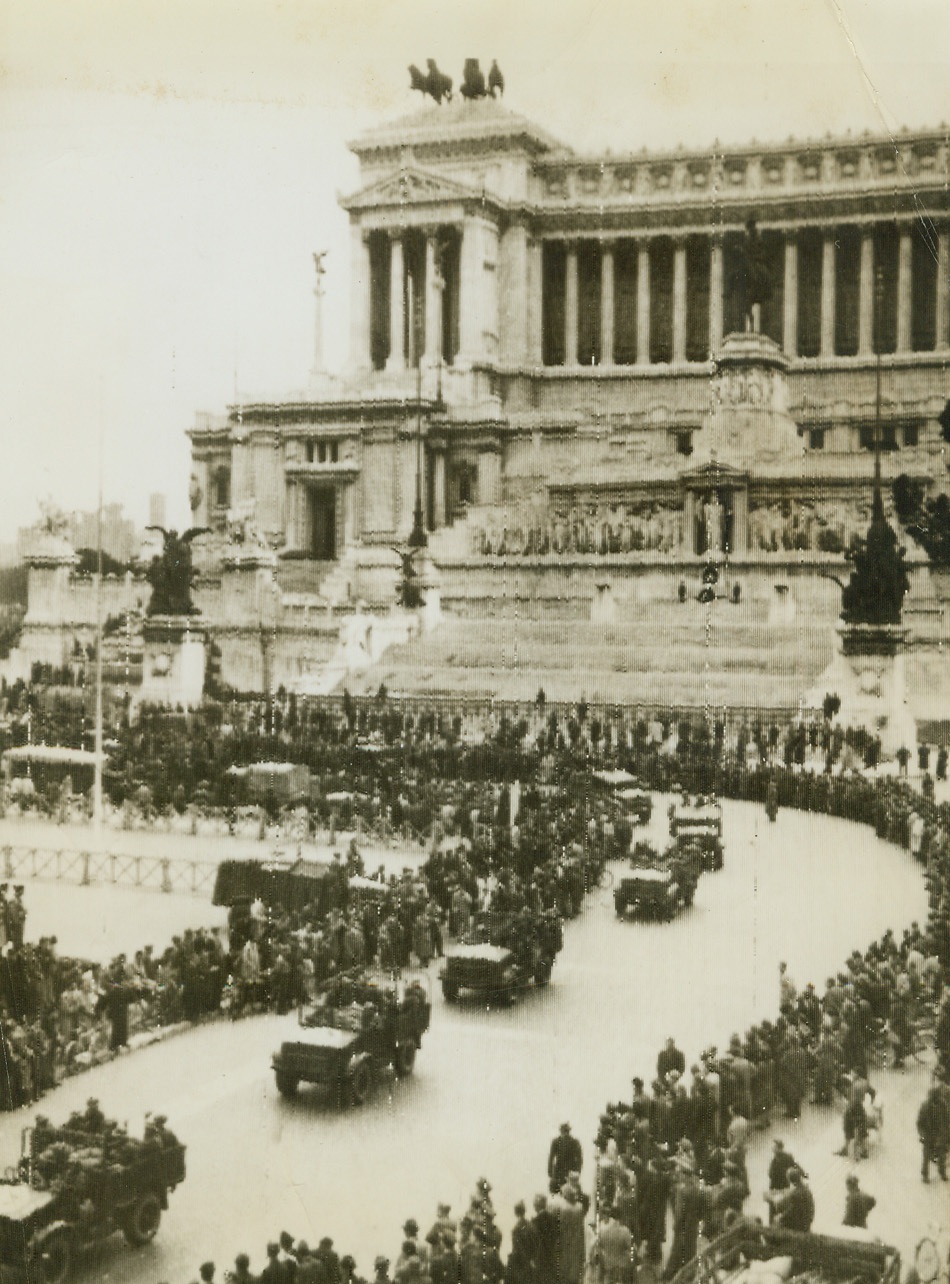
Italian Troops Parade in Rome, 11/25/1944. ROME – Jeeps filled with Italian troops roll past the imposing Victor Emanuel Memorial in Rome during a parade in which they were reviewed by Prince Umberto. These soldiers of Italy now march as free men no longer under Fascist rule and go into battle against their former Axis partner, Germany, willingly.Credit (OWI Radiophoto from Acme);
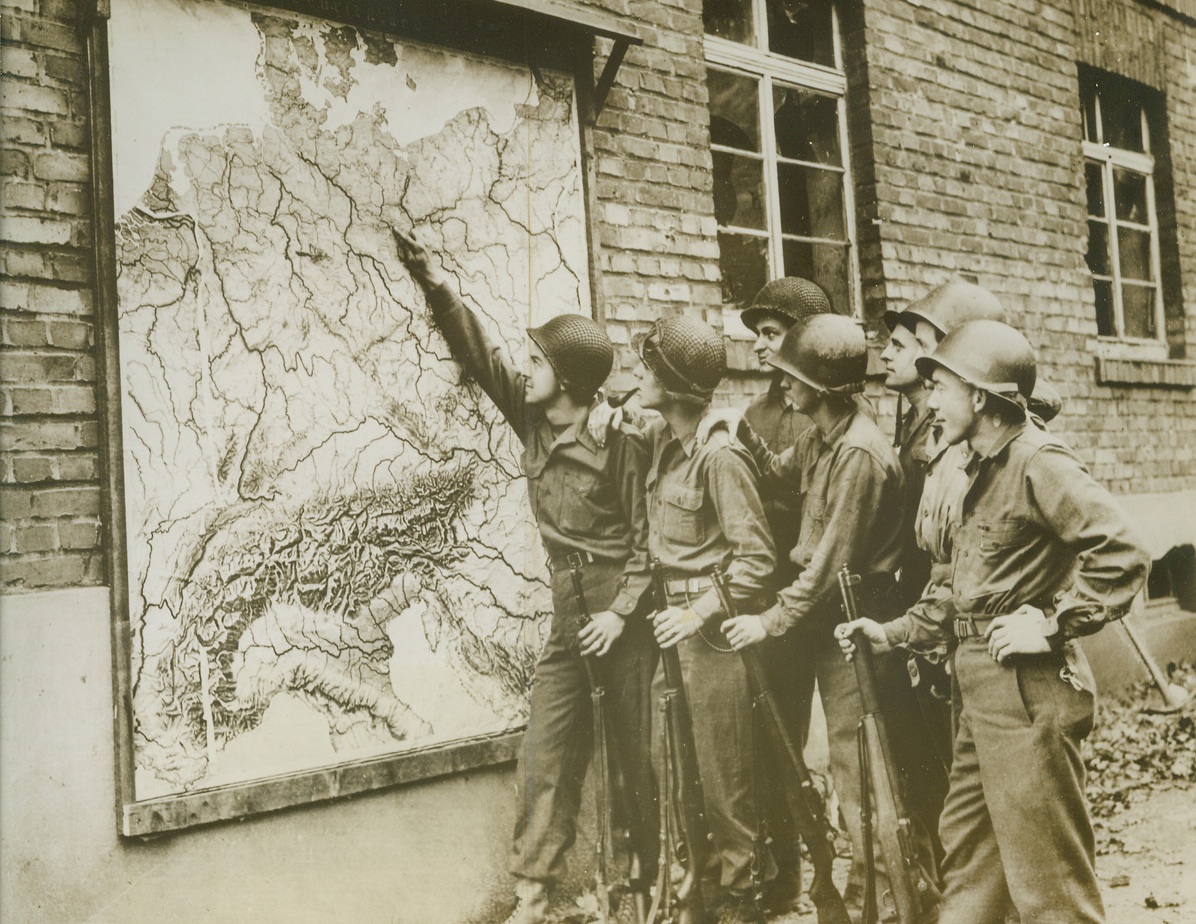
GERMAN MAP AIDS AMERICANS, 11/10/1944. GERMANY—A German map, set up on the side of a building in a captured German town, serves as a guide to the American soldiers now fighting within Germany. Credit: Acme;
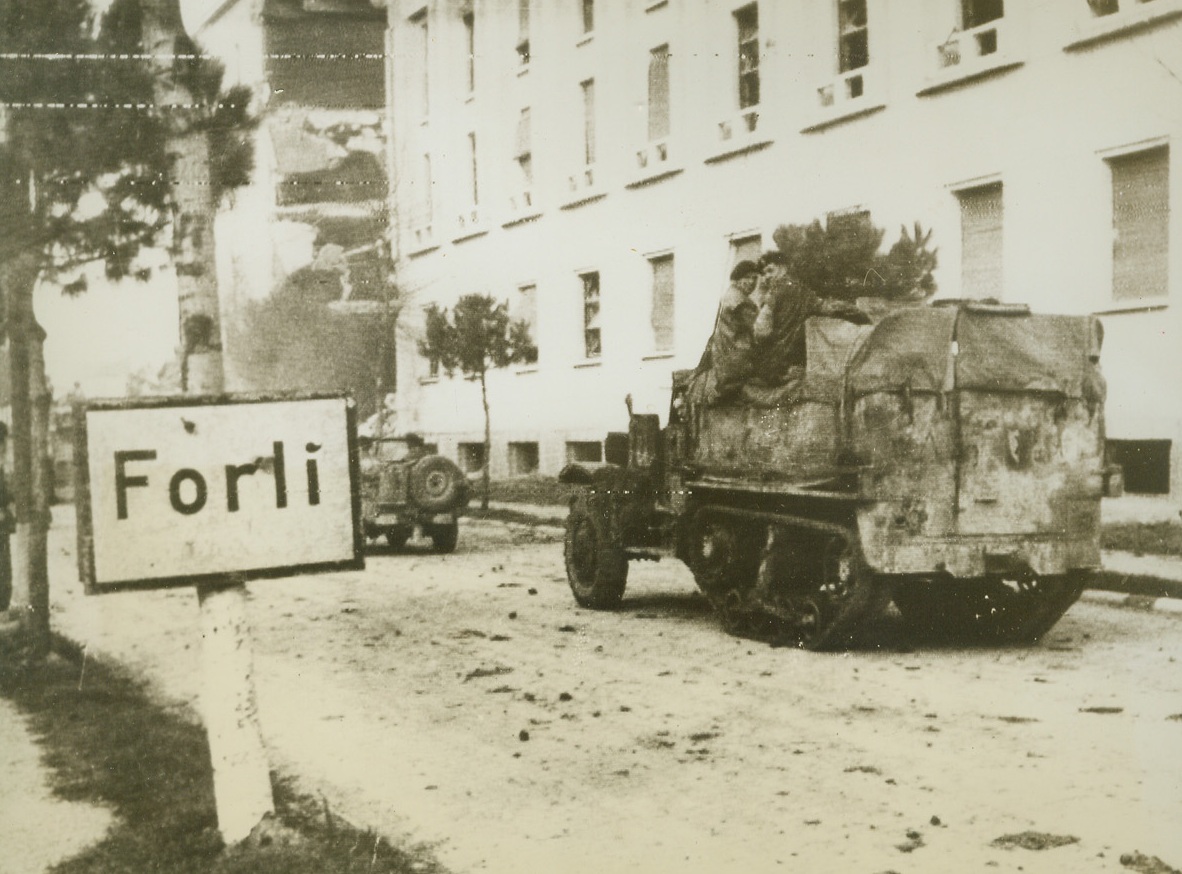
FORLI CLEARED BY 8TH ARMY, 11/10/1944. ITALY—British troops of the 8th Army have completed the conquest of Forli, heart of Italy’s wheat belt, and leading elements have passed through the town and reached the blasted bridge over the Montone River at the extreme western boundary. British tanks and troops are shown passing through the town. Credit (OWI Radiophoto from ACME);
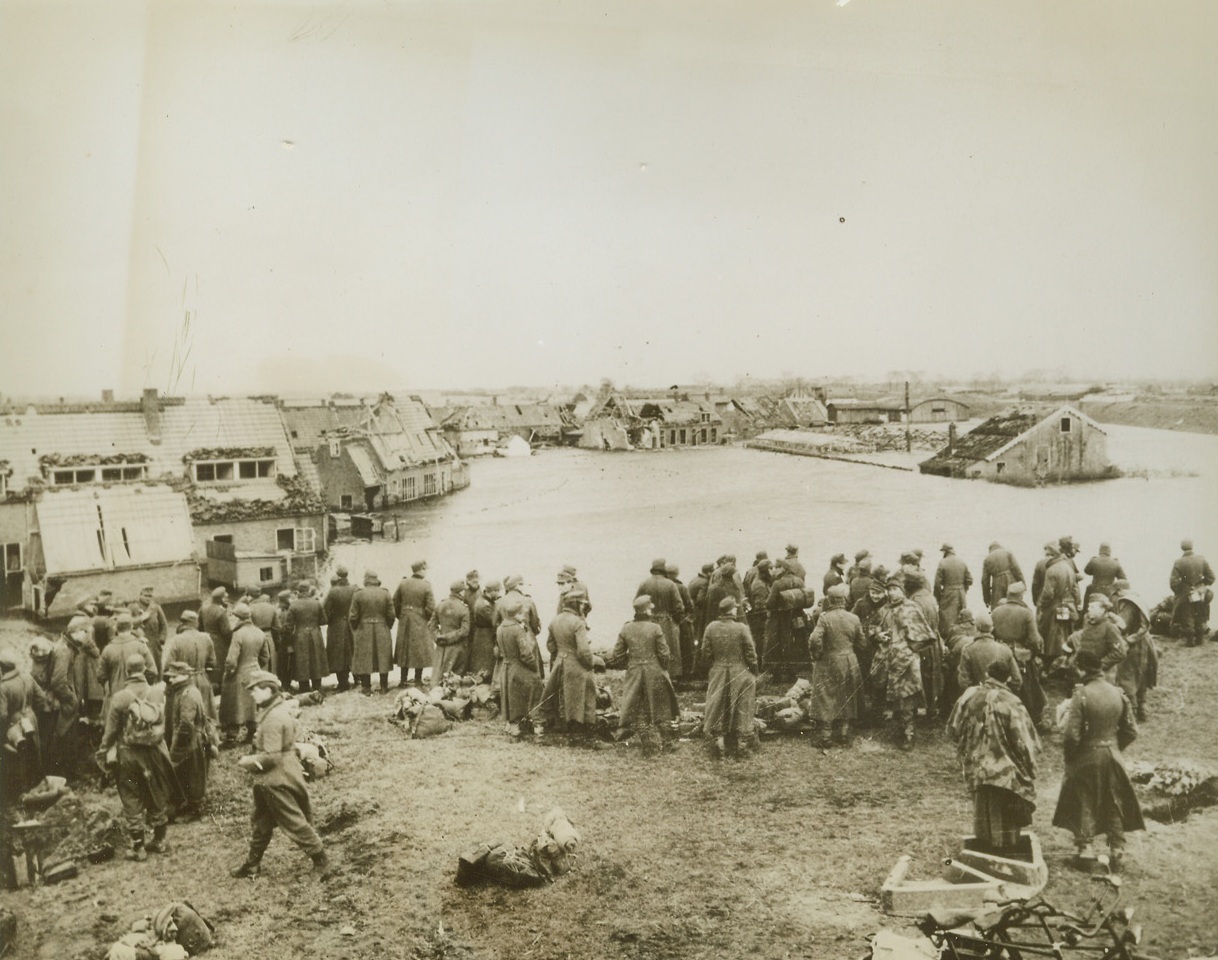
NAZI PRISONERS IN FLOODED DUTCH TOWN, 11/14/1944. HOLLAND—Some of the thousands of Nazis taken prisoner at Middleburg stand on high ground waiting for Allied vessels to carry them across the canal to prison camps. Town in background is almost completely submerged as the sea poured through breaks in dykes opened by Nazi demolition experts. Credit (British Official Photo from ACME);
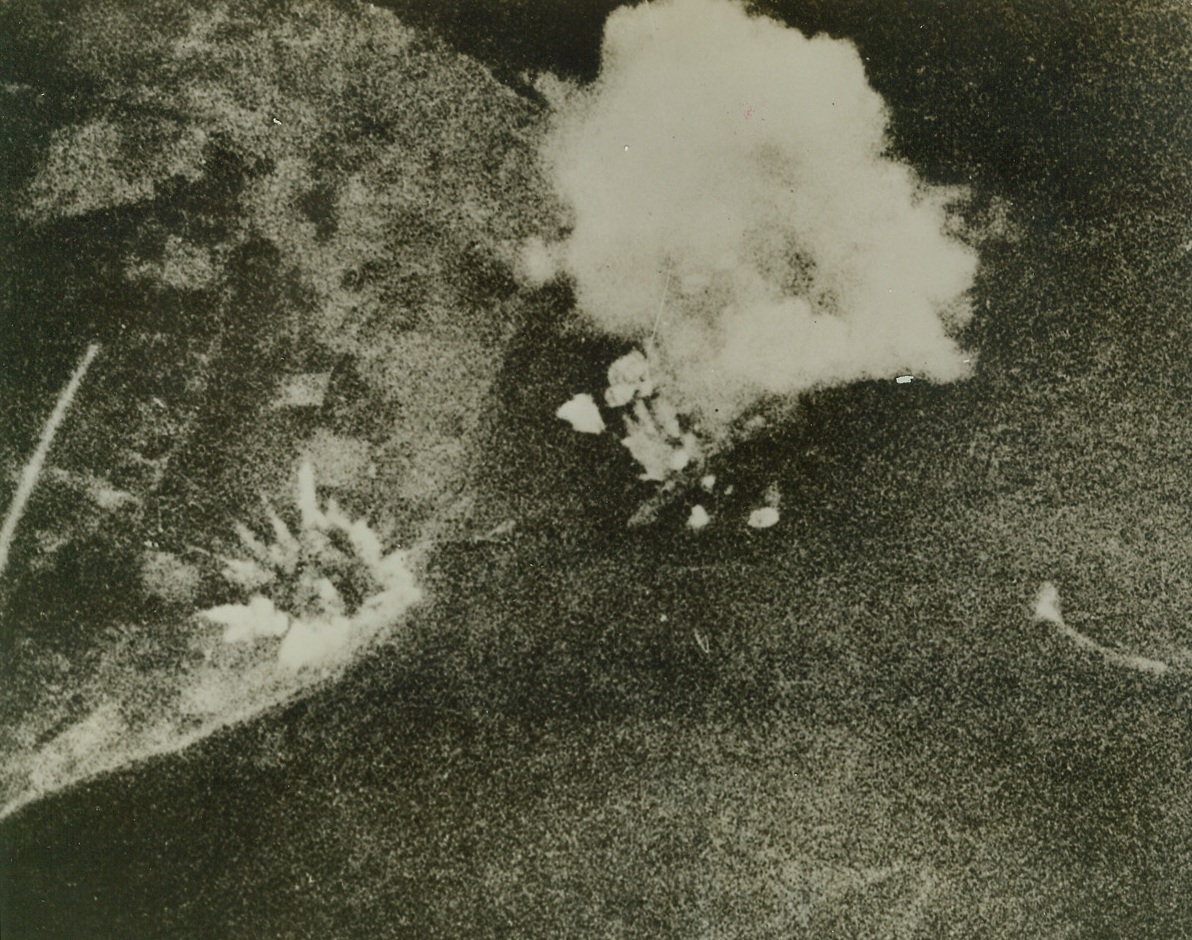
DEATH OF THE TIRPITZ--#2, 11/17/1944. Clouds of smoke envelope the 45,000-ton German battleship Tirpitz as bombs strike home during the Nov. 12 raid by a fleet of 32 RAF Lancaster bombers. Huge dreadnaught can be seen in center of photo at base of large smoke column. The ship was later seen to heel over in the shallow waters of Tromso Fjord, Norway, after at least three 12,000-pound bombs scored direct hits. Smoke mushrooms up at left center as a stray bomb strikes the land. Credit (British Official Photo from ACME);
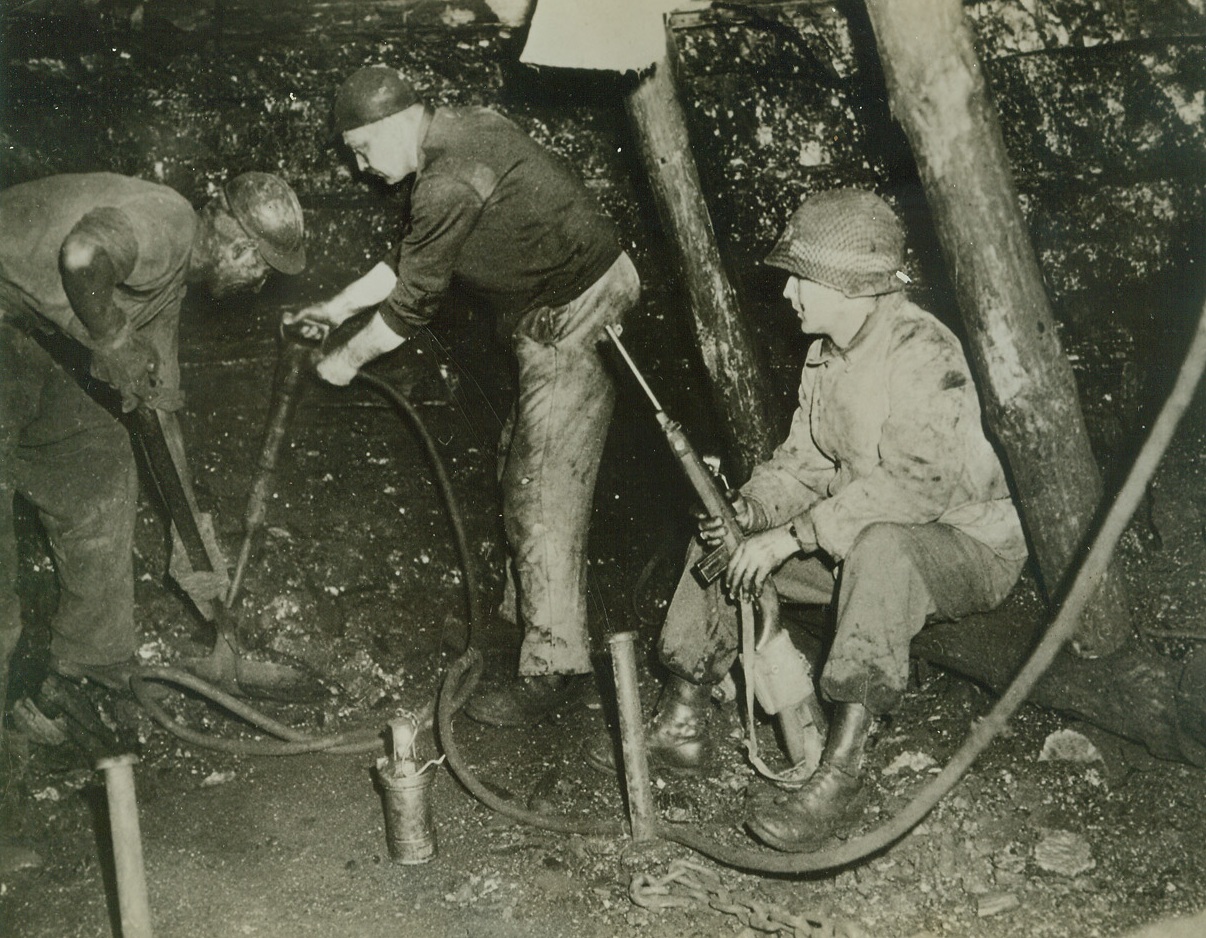
GERMANS AND YANKS OPERATE SAME MINE, 11/5/1944. GERMANY—One of the strangest incidents of this war is taking place at Alsdorf, about 8 miles northeast of Aachen, where Americans and Germans are occupying and working the same coal mine. Part of the mine is on the American side of the fighting line; part on the German side. German miners on both sides continue to get out the coal, but those on the Yank side are under constant guard. Here, Pfc. Ronald H. Meade, Toledo, Oh, watches two German miners at work in the pit. The miners are permitted to go home every evening when their shift is through. Credit (ACME);
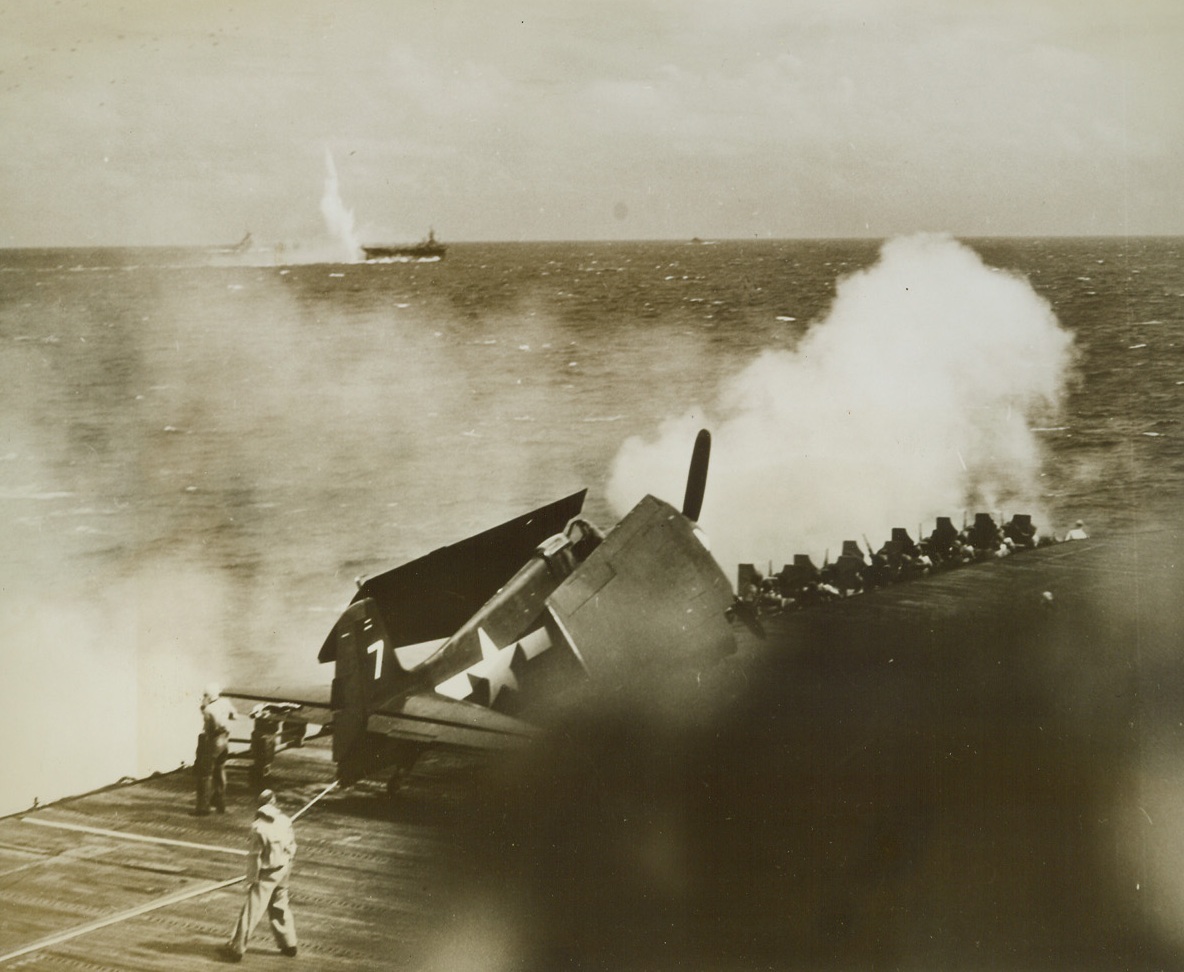
Jap Plane Kayoed by Ack-Ack, 11/17/1944. A Jap plane winds up in a watery finish after being picked out of Pacific skies by the Anti-Aircraft guns of an American Carrier. Even as the plane zooms to a splashy grave, one of its bombs scores a near-miss beside one of our carriers in the background. In the foreground, another carrier, a Grumman Hellcat spotted on the deck, peppers attacking Jap planes with salvos of shells from its anti-aircraft batteries. Exchange took place during the second battle of the Philippine Sea. Credit: U.S. Navy photo from ACME;
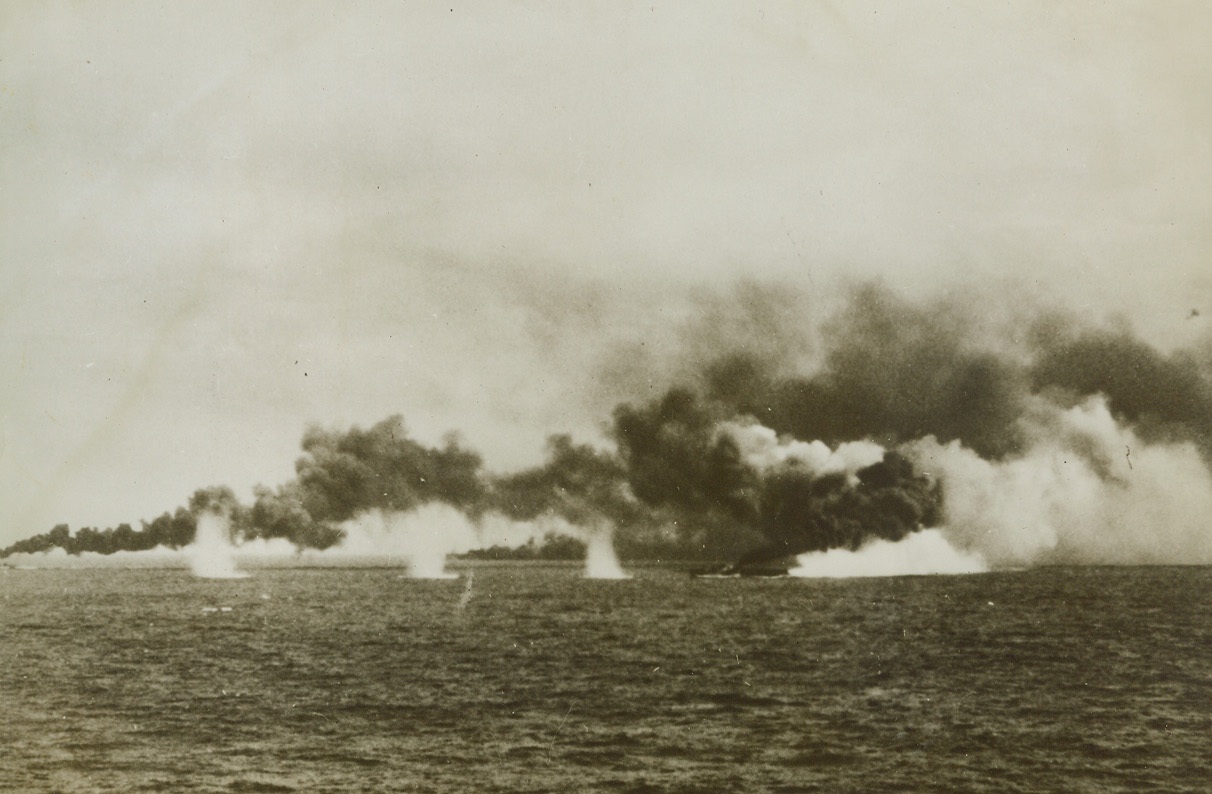
Japs Miss the Boats, 11/17/1944. Water spouts produced by shells fired from badly battered Nip Flotilla, land near two U.S. Destroyers laying smoke screen for Carriers moving into action. Scene occurred during second battle of the Philippine Sea as Japs tried to intercept additional landings of Yank troops. Credit: U.S. Navy photo from ACME;
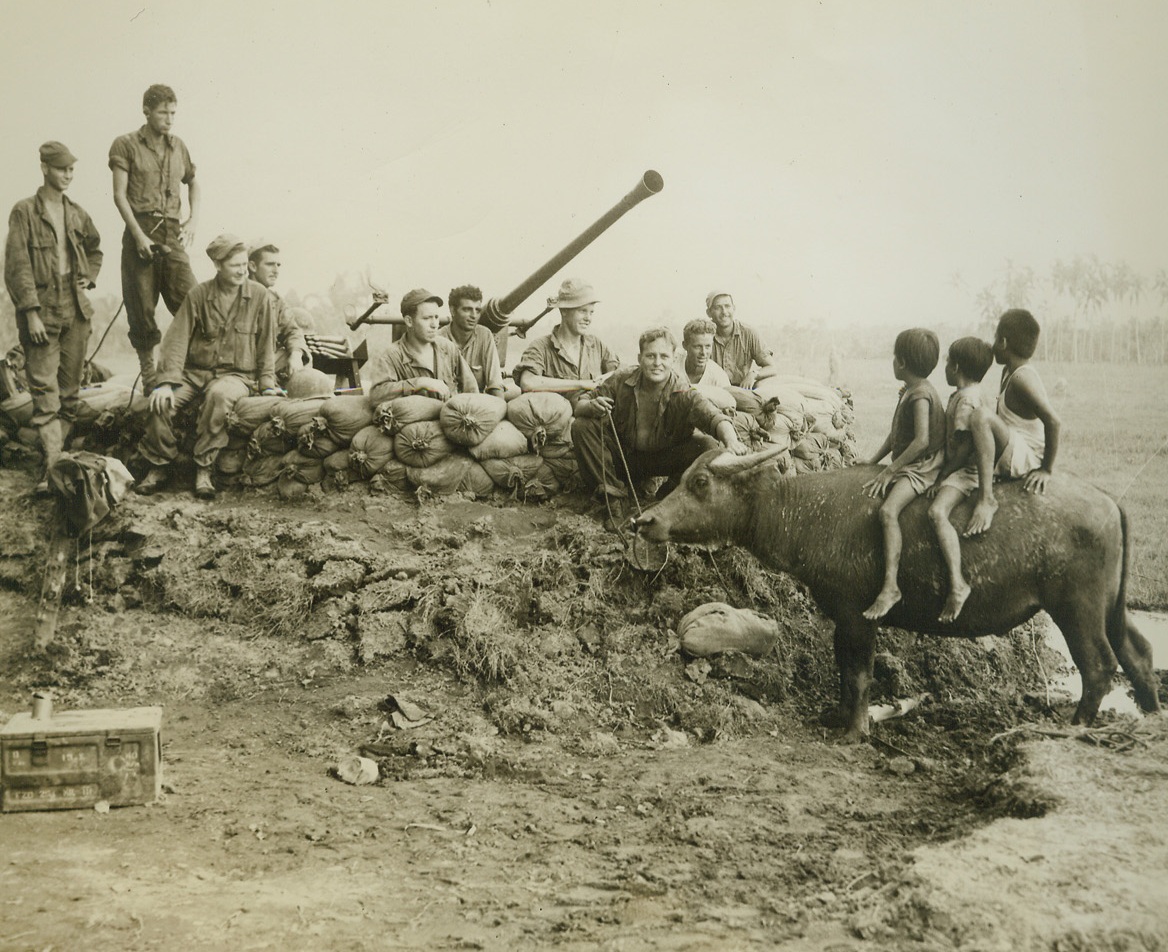
Yanks Find Out “What’s Cooking’”, 11/23/1944. Leyte Island, P.I. – During a lull in the fighting, members of a Yank ack-ack gun crew “shoot the bull” with three small citizens of Leyte island, perched atop their family’s patient caribou. Photo by ACME photographer, Tom Shafer, for the War Picture Pool.Credit-WP-(ACME);
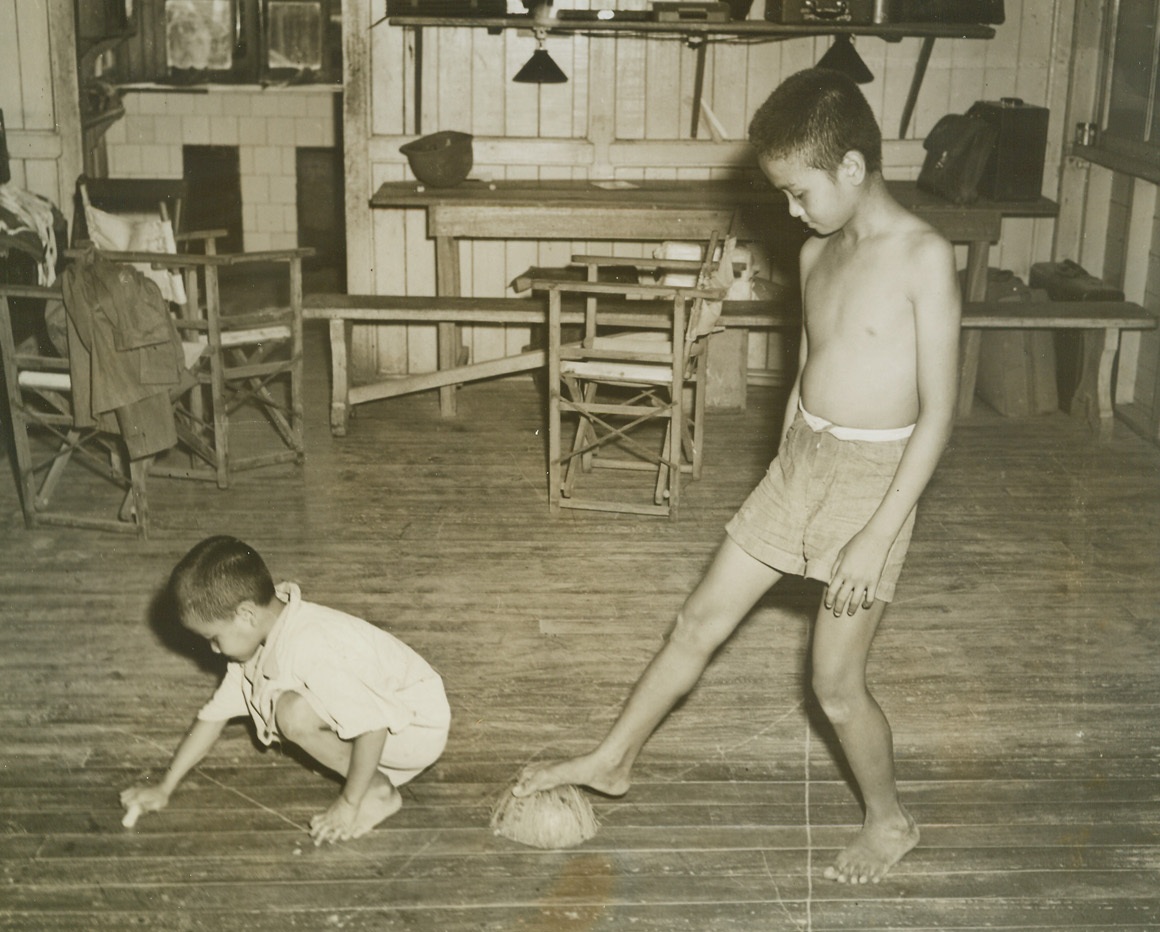
Four Hands Better Than Two, 11/18/1944. Tacloban, P.I. - - Carlos Benitez, 12, and Pablito Benitez, 8, give a demonstration of the Filipino method of polishing the floor. Pablito applies the wax candle stick, then Carlos follows up with his two cocoa nut husks to polish. If Carlos gets tired polishing with his hands he’s just as capable of continuing his work with his foot: Note the difference in polished and unpolished floor.Credit (ACME photo by Stanley Troutman, War Pool Correspondent);
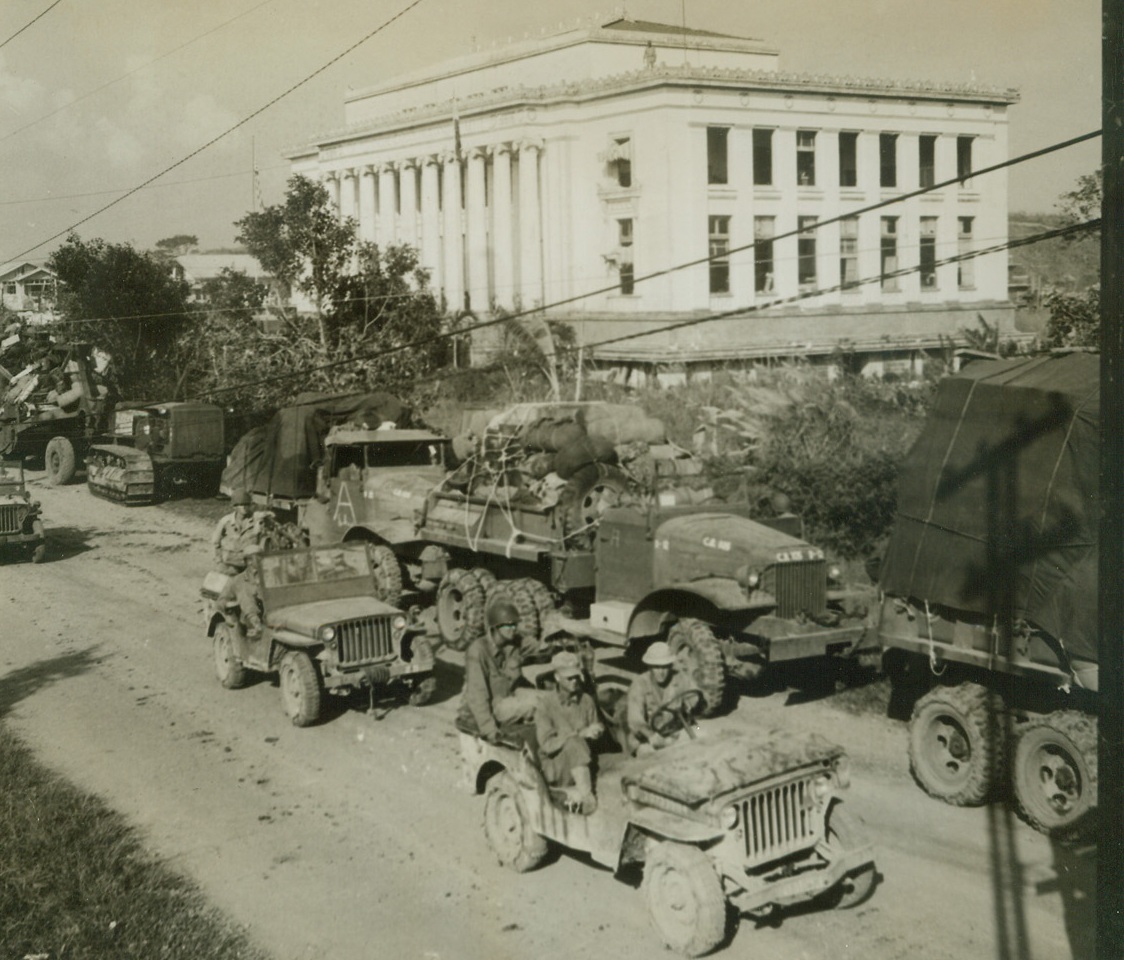
Yanks Move Through Leyte Capital, 11/5/1944. Tacloban, P.I. – As the new Philippine government begins operations in the large white capital building (background) in Tacloban, capital of Leyte, US Army supplies and equipment move through the island capital to the front lines as fighting for the island enters its final stages.;
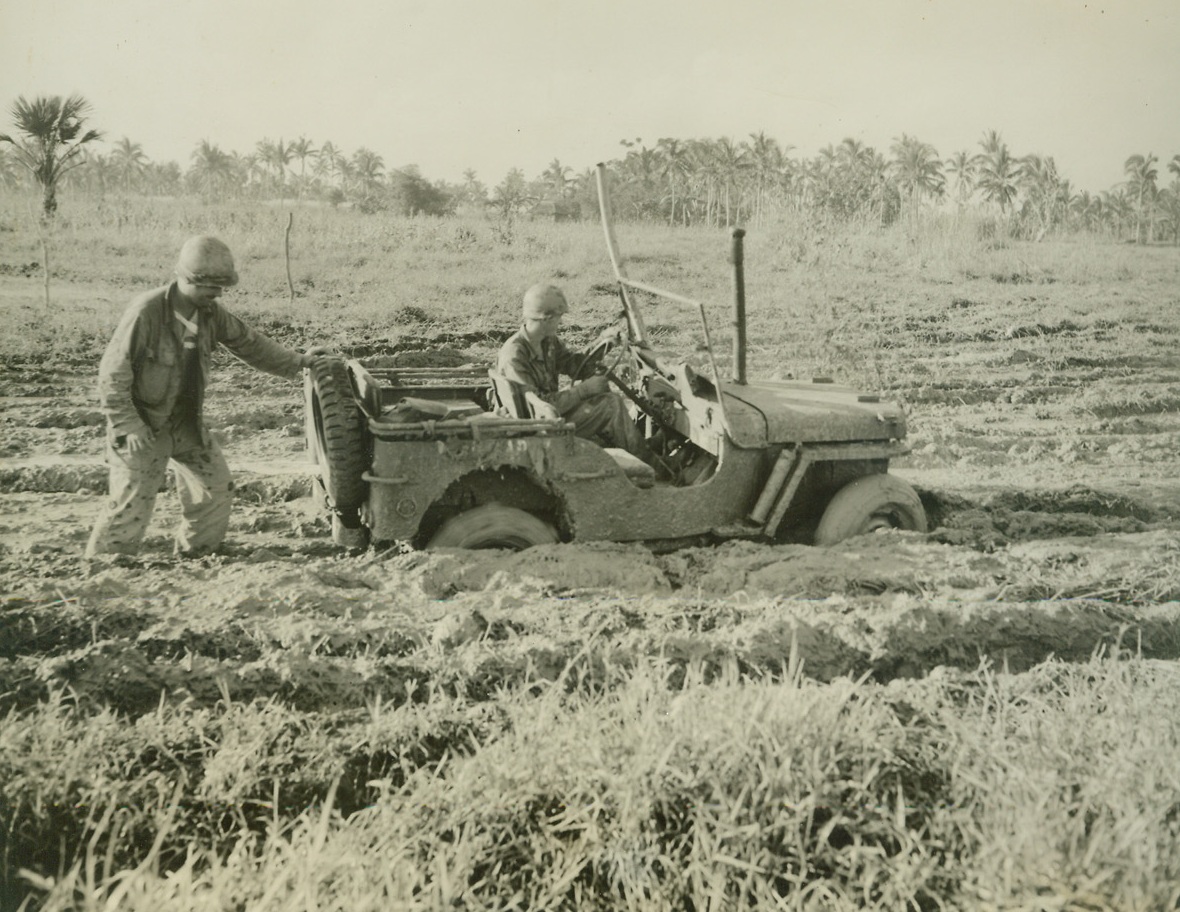
No Title. 11/6/1944. Leyte, P.I. – One of the most natural obstacles which confronted Americans as they landed on Leyte to drive out the Japs was the mud. Thick and slimy, it bogged down mechanized vehicles and slowed the advance of the infantry. Here, Cpl. William Stahl, Kansas City, MO., tries to drive his jeep out of a mud bog, in which he car sunk to the top of the wheels. Lt. John A. Farnsworth, San Francisco, is pushing from the back.Credit (ACME photo by Stanley Troutman, War Pool Correspondent);
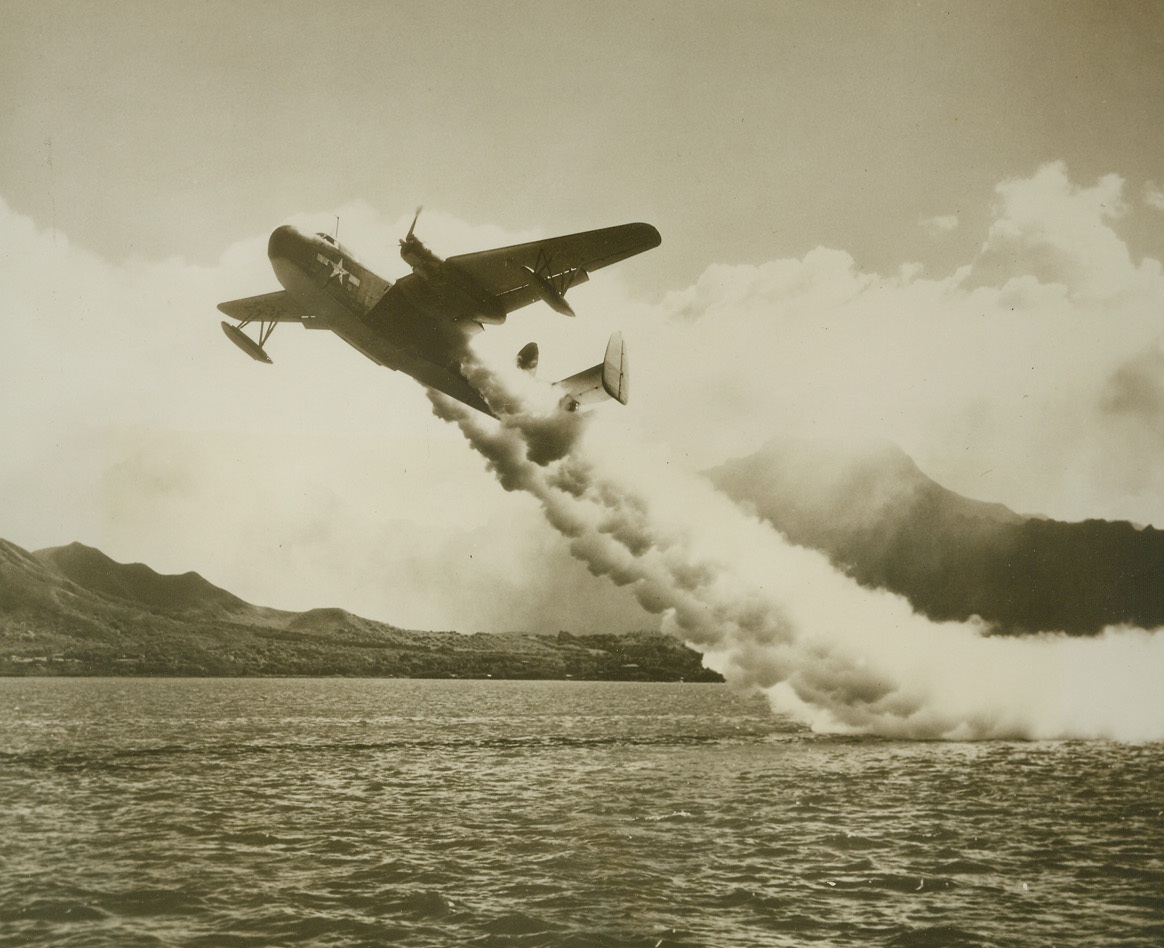
Jet-Propelled Take-off for Mariner, 11/9/1944. South Pacific – As the massive, bi-motored Martin mariner rises into the air, streams of smoke are ejected from the rockets situated under the wings. Jet propulsion is being more and more widely used to assist in speedy take-offs for more cumbersome planes. This picture was taken at a Pacific base by the new power-driven, portable K-25 camera.Credit (Official US Navy photo taken from ACME);
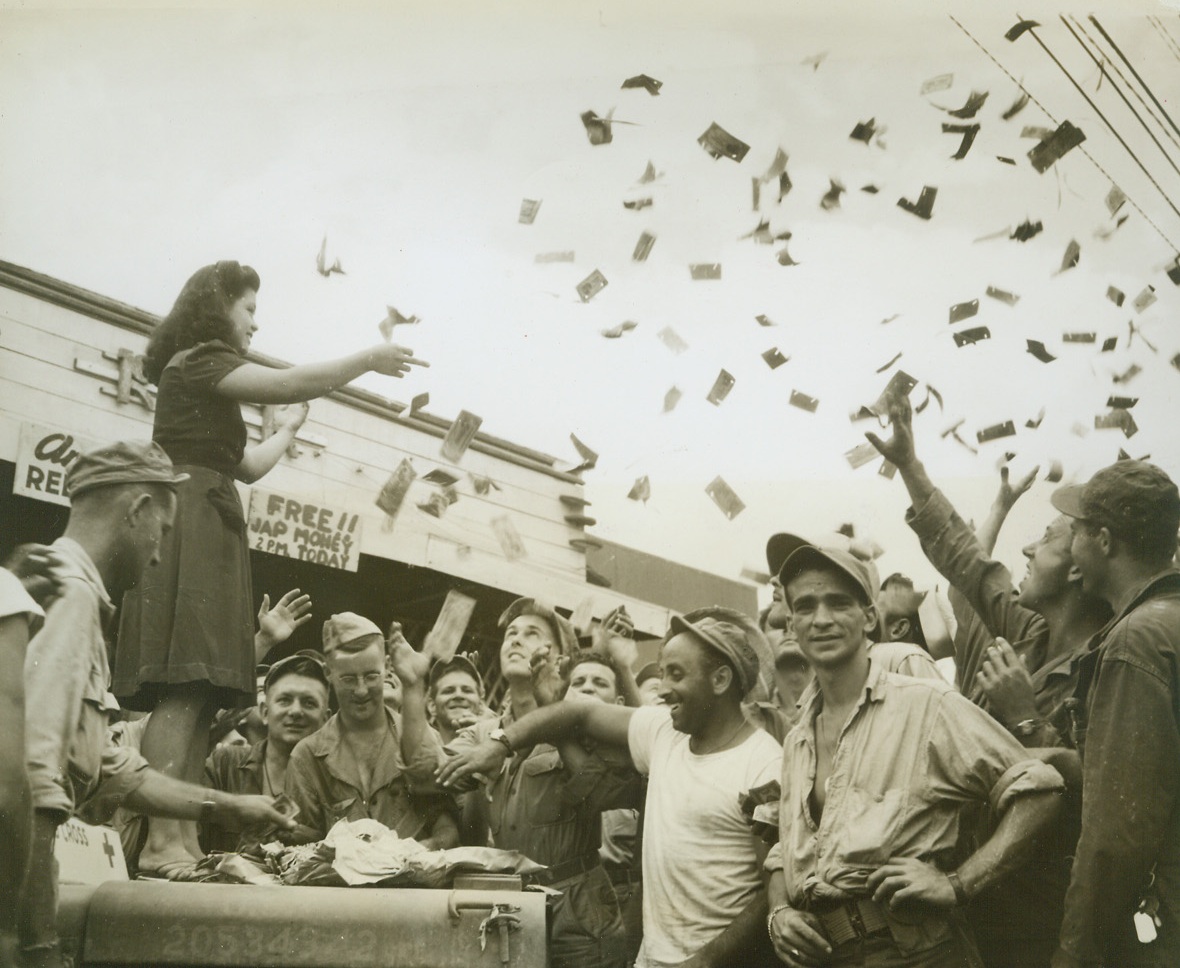
Jap Money - -For Free, 11/15/1944. Leyte- - When civil authorities encouraged the disposing of 4,000,000 valueless pesos in Jap invasion currency, a Red Cross party was held and the worthless cash thrown to American soldiers and sailors. In Tacloban, they are shown grabbing for “pesos from heaven.” This is one of the last pictures made by Acme Photographer, Frank Prist, Jr., for the War Picture Pool, who was instantly killed by a Japanese sniper bullet in Western Leyte.Credit-WP-(ACME);
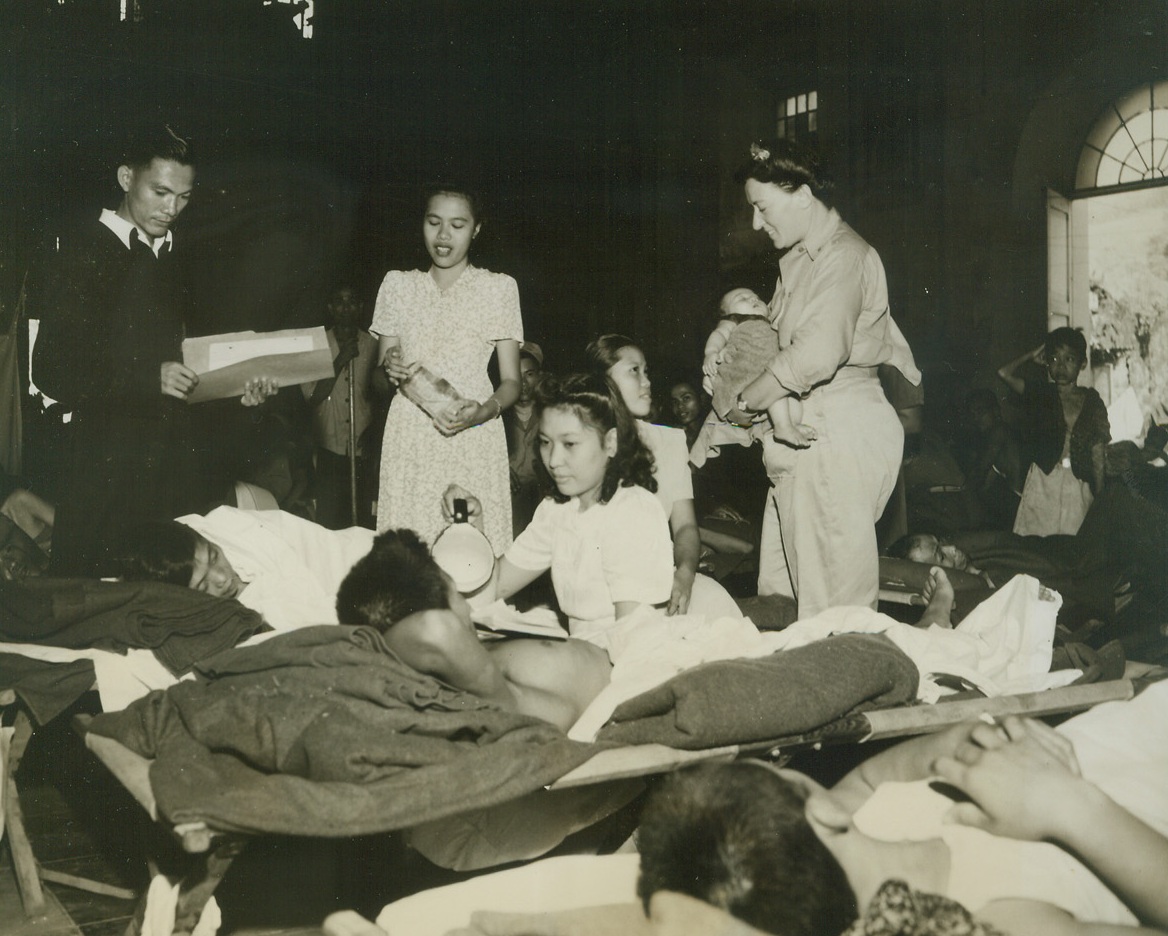
Army Nurses Give Aid Where Needed, 11/15/1944. Philippines—U.S. Army nurses in the Philippines are faced with all types of cases. They care for the wounded, American and Filipino, tend the sick and feed the undernourished and when called upon, give comfort to the orphaned children. Here Lt. Rose Chapman of Chicago, Ill., takes care of a native baby whose father had been brought to the field hospital set up in a Cathedral on Leyte Island. Looking on is Father Antonio Mate, Filipino priest. This is one of the last pictures taken by Frank Prist, Jr., ACME photographer for the War Picture Pool, who was instantly killed by a Japanese sniper bullet while cover the front in Western Leyte.Credit-WP- (ACME);
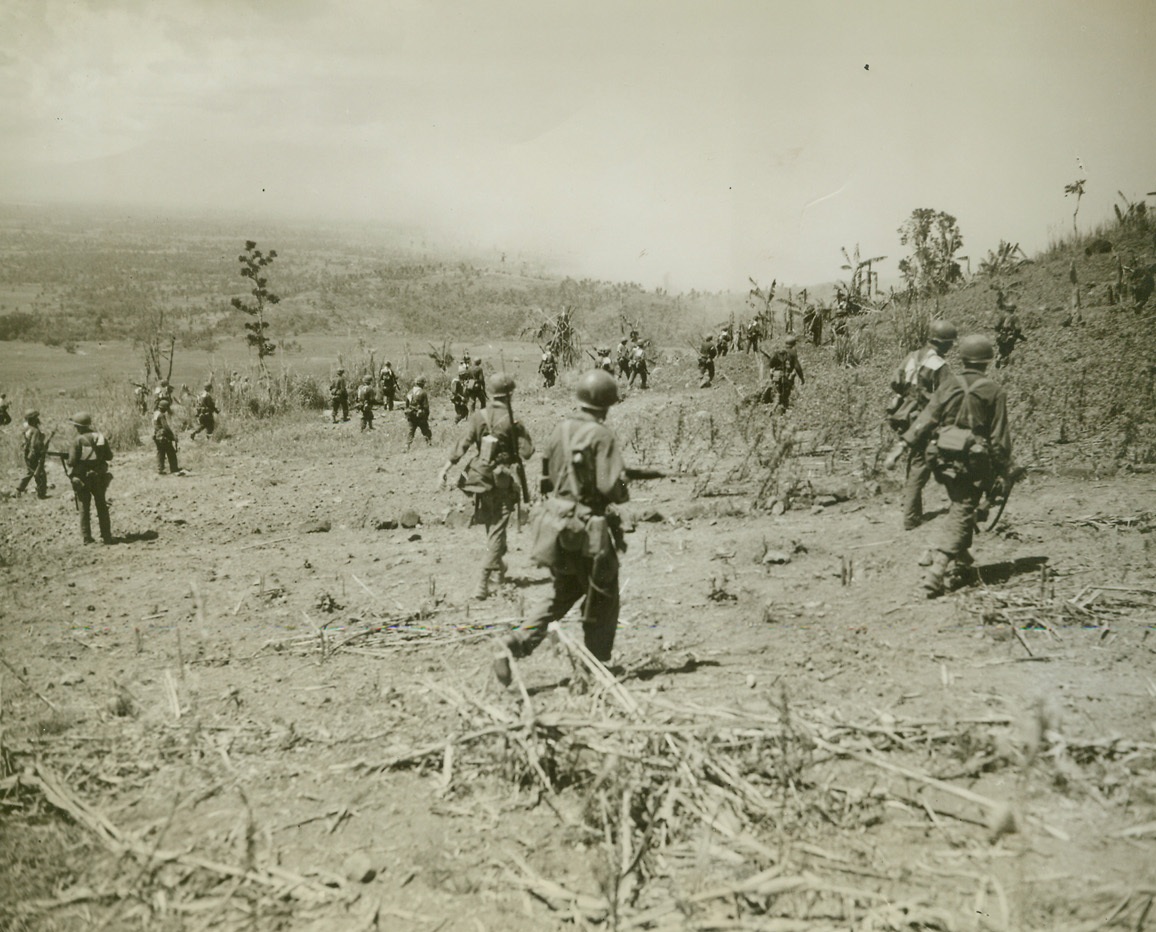
Stalking the Jap, 11/13/1944. Leyte, Philippines – Hurrying across the stubble-strewn wasteland of Leyte island, infantrymen of the U.S. 96th Div. advance across Catamon Hill to hunt the Jap in his own territory. Photo by Stanley Troutman, ACME photographer for the War Picture Pool.Credit Line-WP-(ACME);
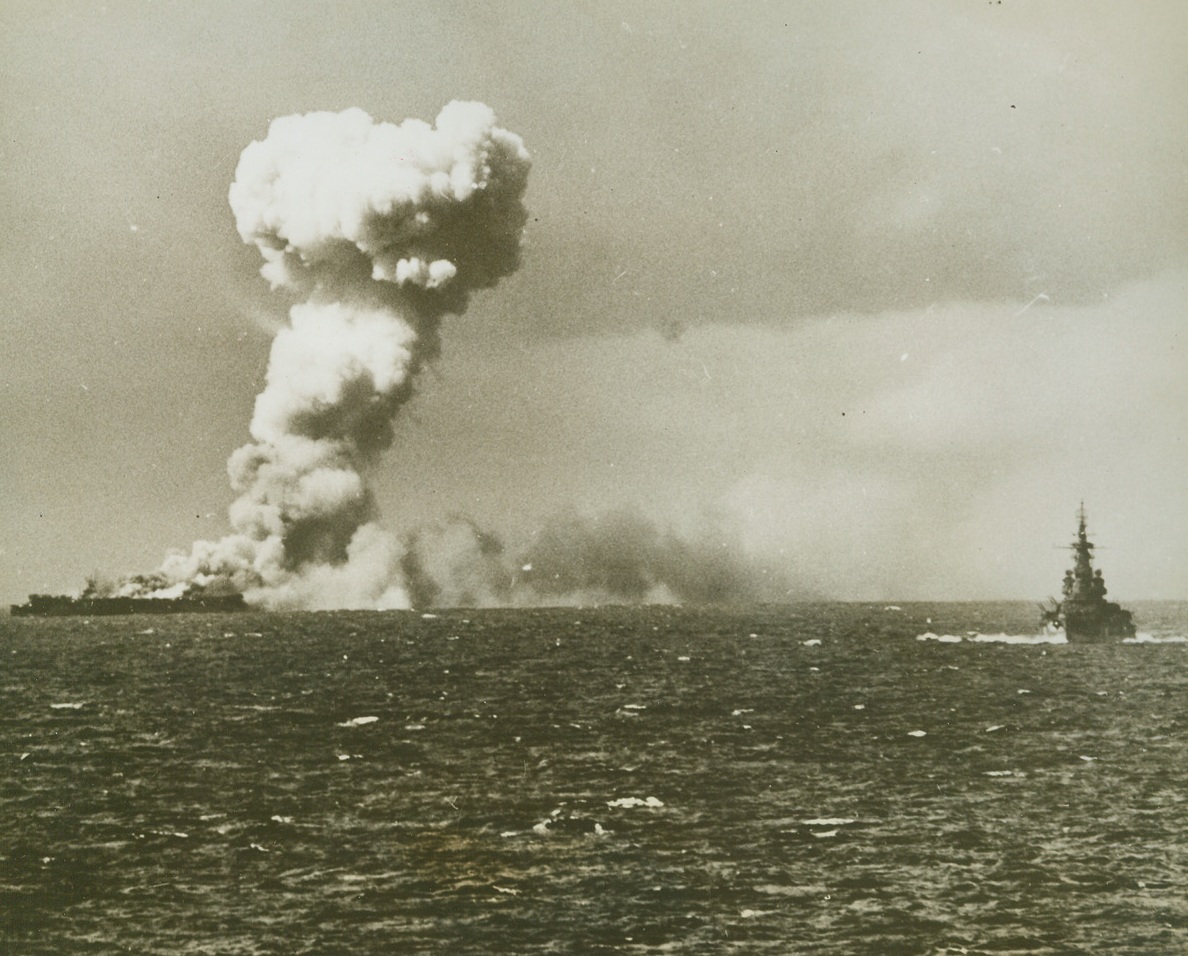
Princeton’s Death Scene, 11/17/1944. Smoke mushrooms from U.S. light carrier Princeton as the doomed ship is torn by explosions following direct hit by Jap bombers in second battle of the Philippine sea. U.S. warship at right stands by.Credit (U.S. Navy photo from ACME);
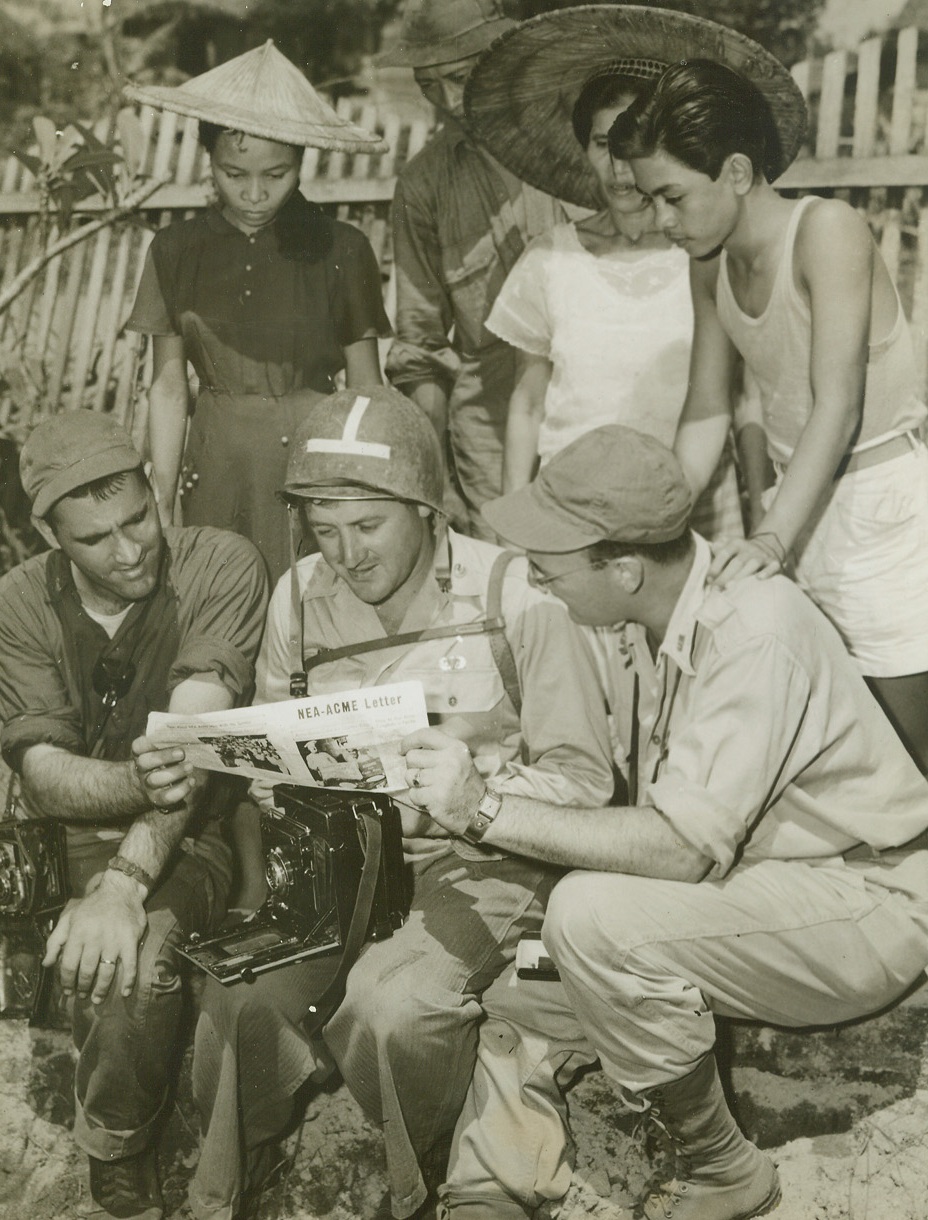
ACME Cameraman Reported Killed, 11/14/1944. Leyte, Philippines – This is probably one of the last photos of ACME Correspondent Frank Prist, Jr. (center) who has been reported killed in the Philippines. With him reading inter-office paper are Stanley Troutman (left) and Tom Shafer (right), who are also covering the U.S. offensive on Leyte.Credit Line-WP-(ACME photo by Stanley Troutman, War Pool Correspondent);
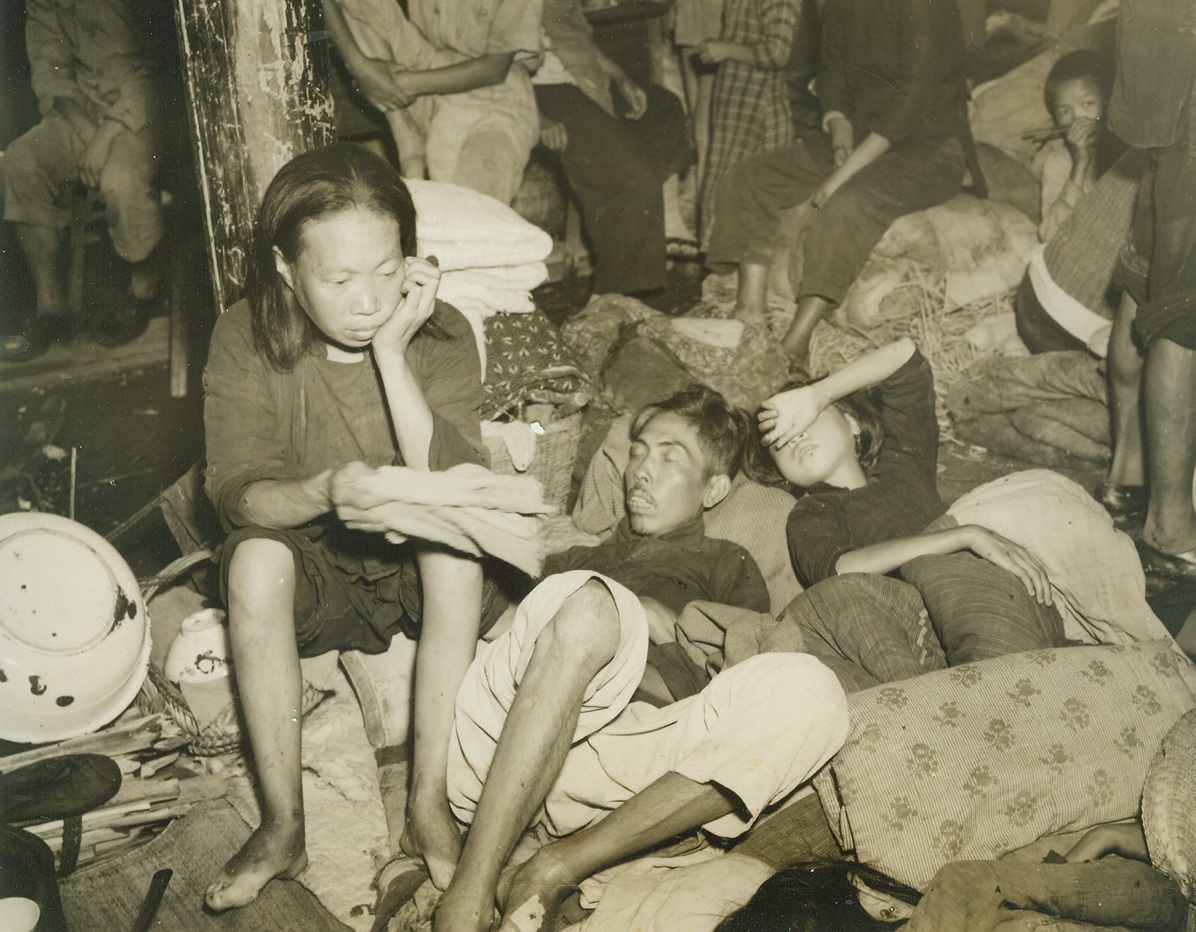
CHINA’S HUMAN CARGO, 11/10/1944. EASTERN FRONT, CHINA—Masses of humanity, united in one common purpose—flight for life—cram the railroads and highways leading from China’s Eastern Front, as the instinct for self-preservation sends them fleeing from Jap terror. Simple peasants they are, familiar with only the ways of simple folk like themselves, but they well know the atrocities of the Japs. Rather than live under the yoke of the Rising Sun, they choose to suffer hardship, and even death, to evade them. Trains leaving Liuchow are packed from the rails to the tops of the cars, and all available vehicles fill the highway as shown in this unusual and dramatic series of photos made by Frank Cancellare, ACME photographer for the War Picture Pool. On the heels of the evacuees follow constantly the fear of the dread typhus and cholera epidemics, but still they go onward. A look of horelessness on her face, this Chinese woman sits in a railroad station the insects from other members of the family, who are trying to get a little sleep. Their bodies are thin and sickly, and covered with insect bites. They are warned to watch these bites, as insects in this area are the carriers of typhus and dread diseases. Photo by ACME photographer, Frank Cancellare, for the War Picture Pool. Credit: ACME.;
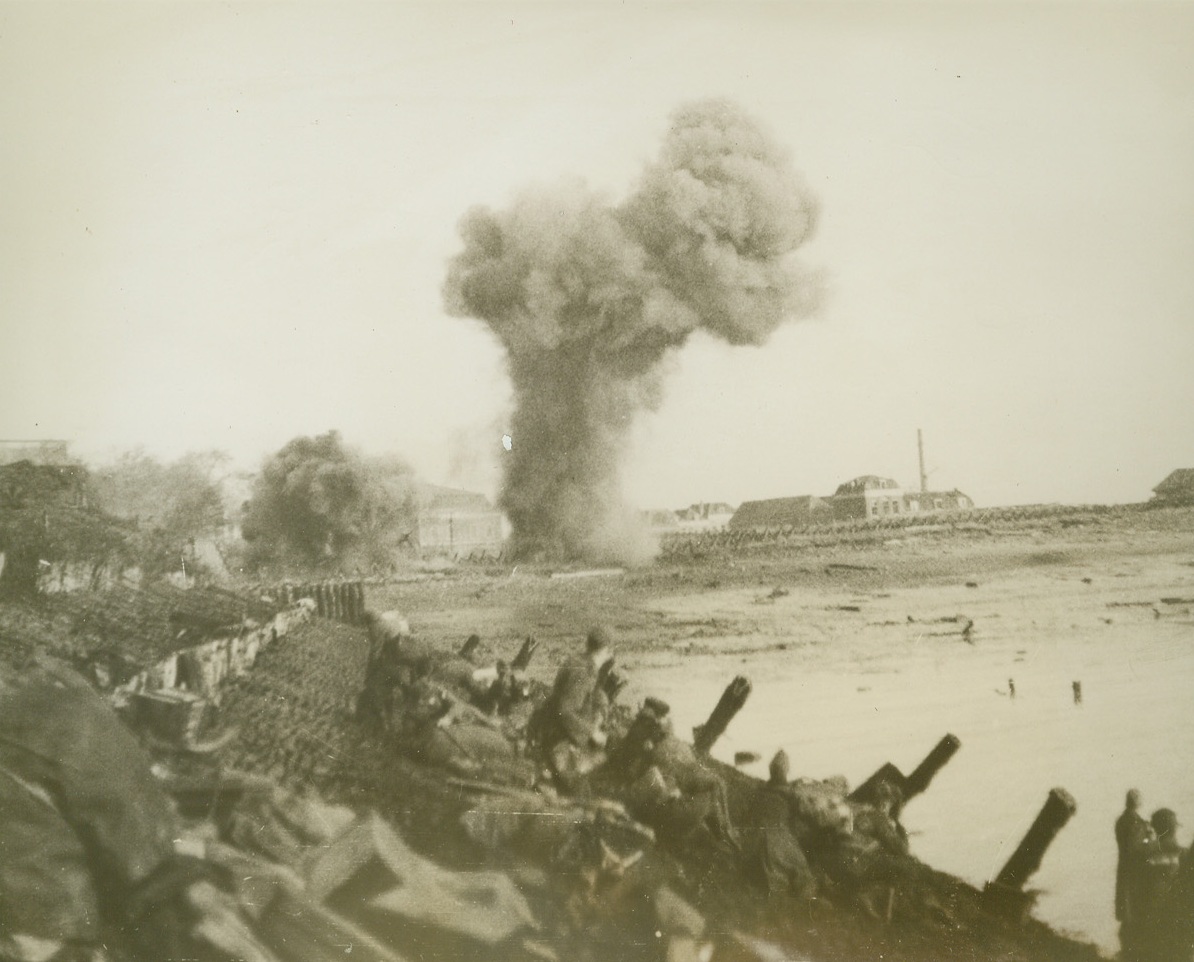
BRITISH COMMANDOS MOVE ON TO WALCHEREN, 11/10/1944. FLUSHING, WALCHEREN IS.—With geysers of earth and water rising in the background, British Commando units advance slowly along the beach at Walcheren, during the initial landings at Flushing on Nov. 1 After the first assault, the troops moved onto West Kapelle to form a second bridgehead. Credit: BRITISH OFFICIAL PHOTO FROM ACME.;
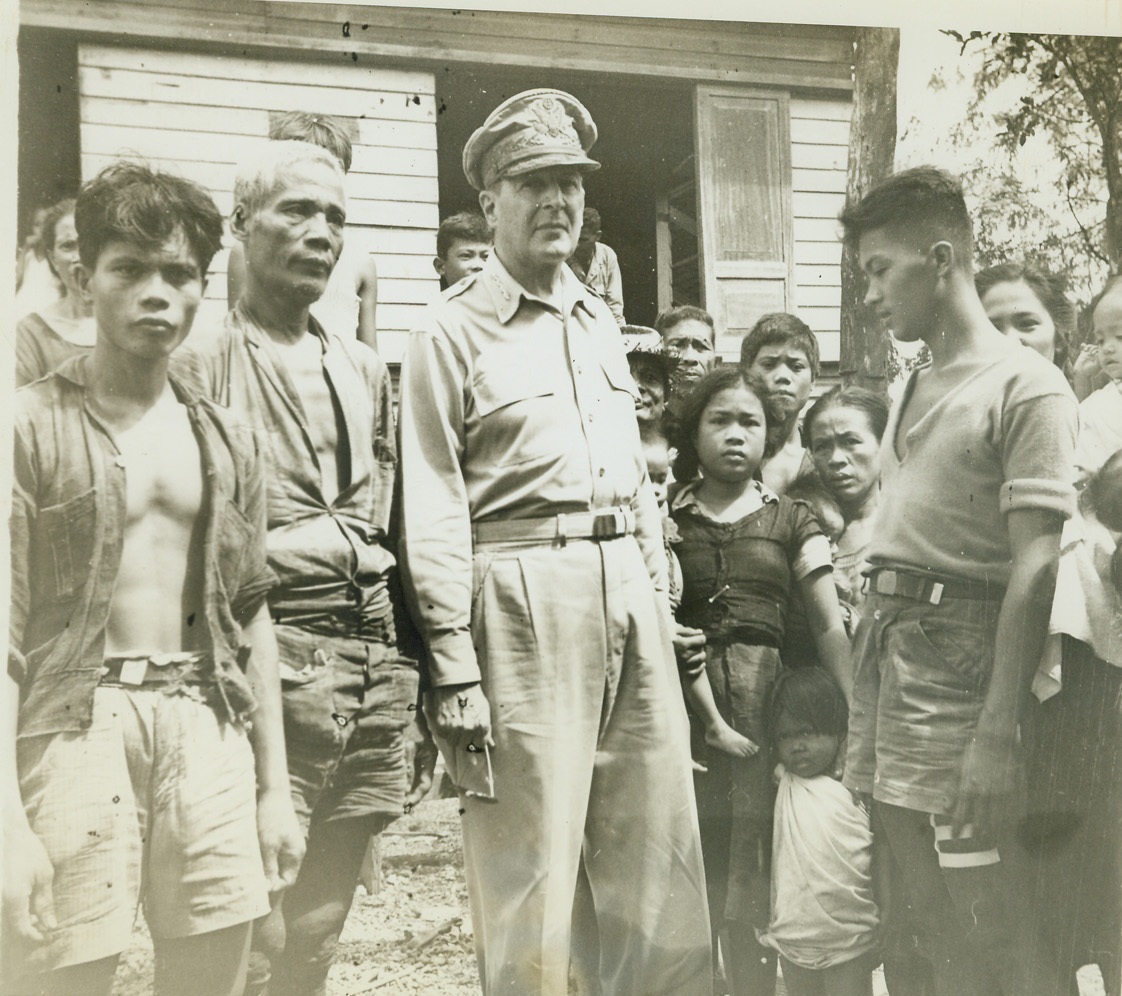
"Mac" Returned to Free Them, 11/1/1944. LEYTE ISLAND, PHILIPPINES -- Anxious to greet their liberator, Filipinos cluster around General Douglas MacArthur, who made good his promise to return and free the Islanders. Photo by ACME Photographer Thomas L. Shafer for the War Picture Pool. Credit: (ACME) -- WP;
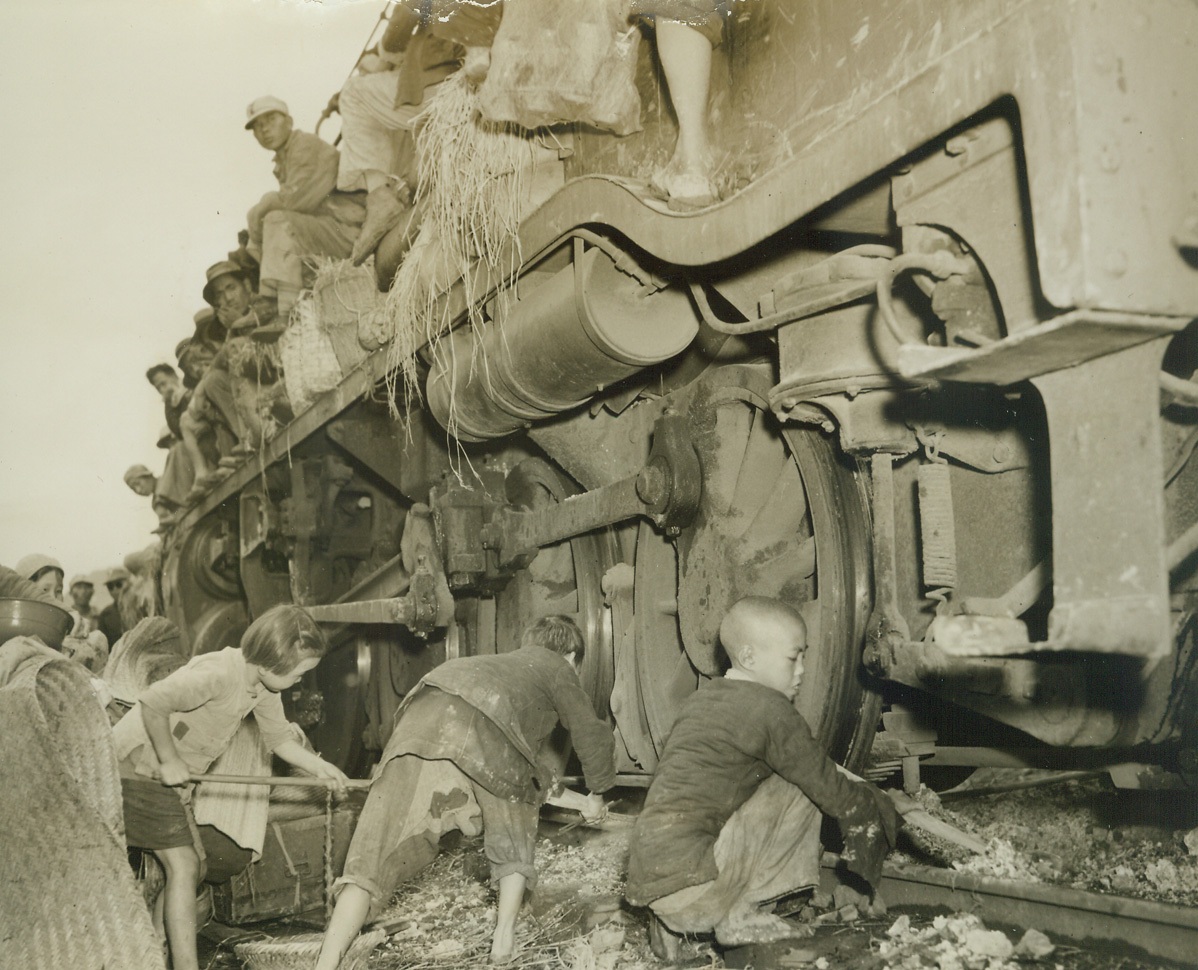
China’s Human Cargo, 11/10/1944. Eastern Front, China – Masses of humanity, united in one common purpose – flight for life—cram the railroads and highways leading from China’s Eastern front, as the instinct for self preservation sends them fleeing from Jap terror. Simple peasants they are, familiar with only the ways of simple folk like themselves, but they know the atrocities of the Japs, rather than live under the yoke or the rising sun, they choose to suffer hardship, and even death, to evade them. Trains leaving Liuchow are packed from the rails to the tops of the cars, and all available vehicles fill the highway as shown in this unusual and dramatic series of photos made by Frank Cancellare, ACME photographer for the War Picture Pool On the heels of the evacuees follow constantly the fear of the dread typhus and cholera epidemic but still they go onward. New York Bureau As this train locomotive, filled on all sides with refugees and their scant belongings, stops for a short time, young children rush to scoop out the hot ashes from beneath the engine. They will be used for heating purposes. Photo by ACME photographer, Frank Cancellare, for the War Picture Pool. Credit –WP- (ACME);
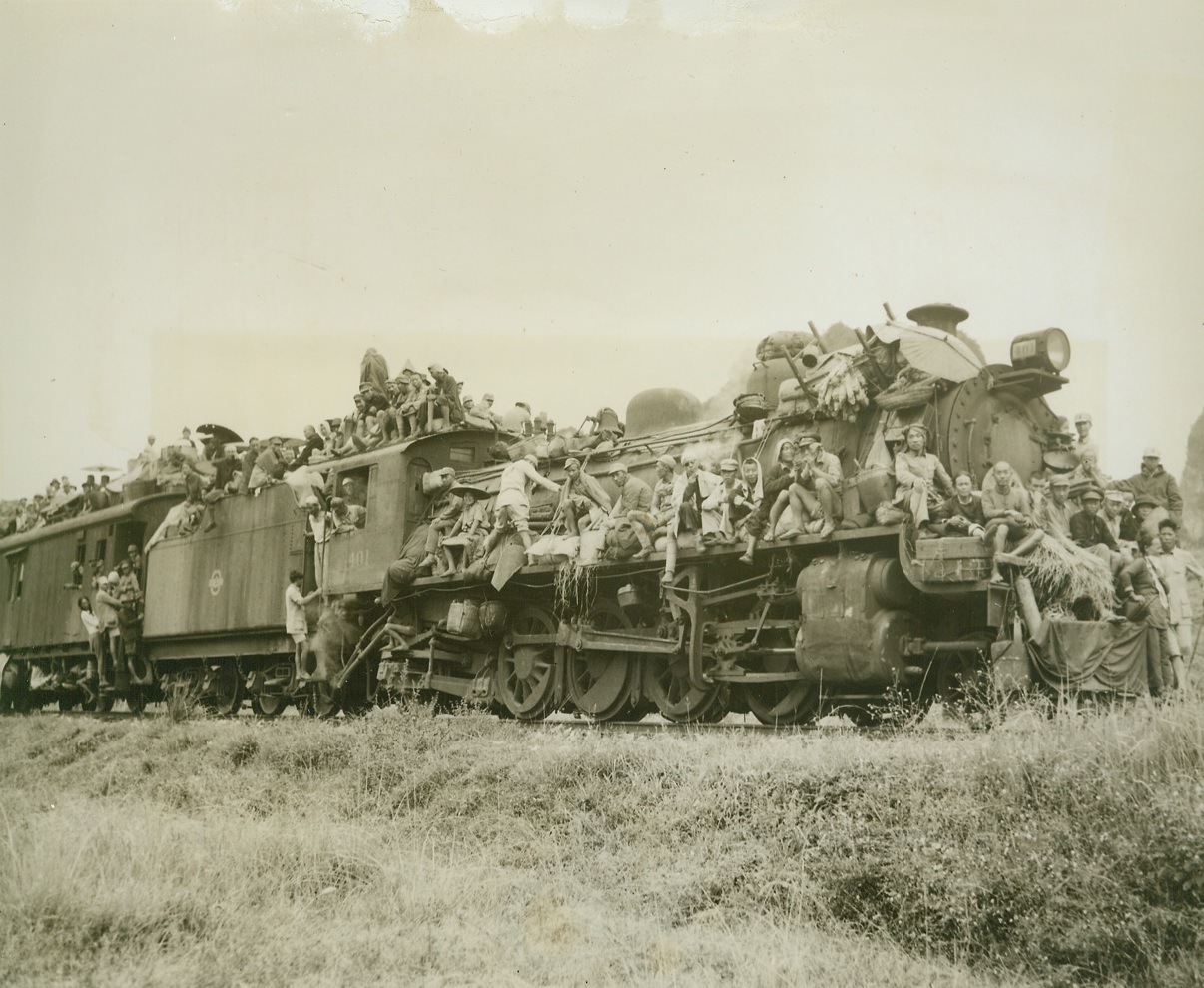
China’s Human Cargo, 11/10/1944. Eastern Front, China – Masses of humanity, united in one common purpose – flight for life—cram the railroads and highways leading from China’s Eastern front, as the instinct for self preservation sends them fleeing from Jap terror. Simple peasants they are, familiar with only the ways of simple folk like themselves, but they know the atrocities of the Japs, rather than live under the yoke or the rising sun, they choose to suffer hardship, and even death, to evade them. Trains leaving Liuchow are packed from the rails to the tops of the cars, and all available vehicles fill the highway as shown in this unusual and dramatic series of photos made by Frank Cancellare, ACME photographer for the War Picture Pool On the heels of the evacuees follow constantly the fear of the dread typhus and cholera epidemic but still they go onward. New York Bureau Every inch of space on this train, from the locomotive back to the “caboose” is filled with refugees. At one time a family of seven, riding atop one of the cars, was killed when the train entered a tunnel, and the low roof swept them off. Photo by ACME photographer, Frank Cancellare, for the War Picture Pool. Credit-WP-(ACME);
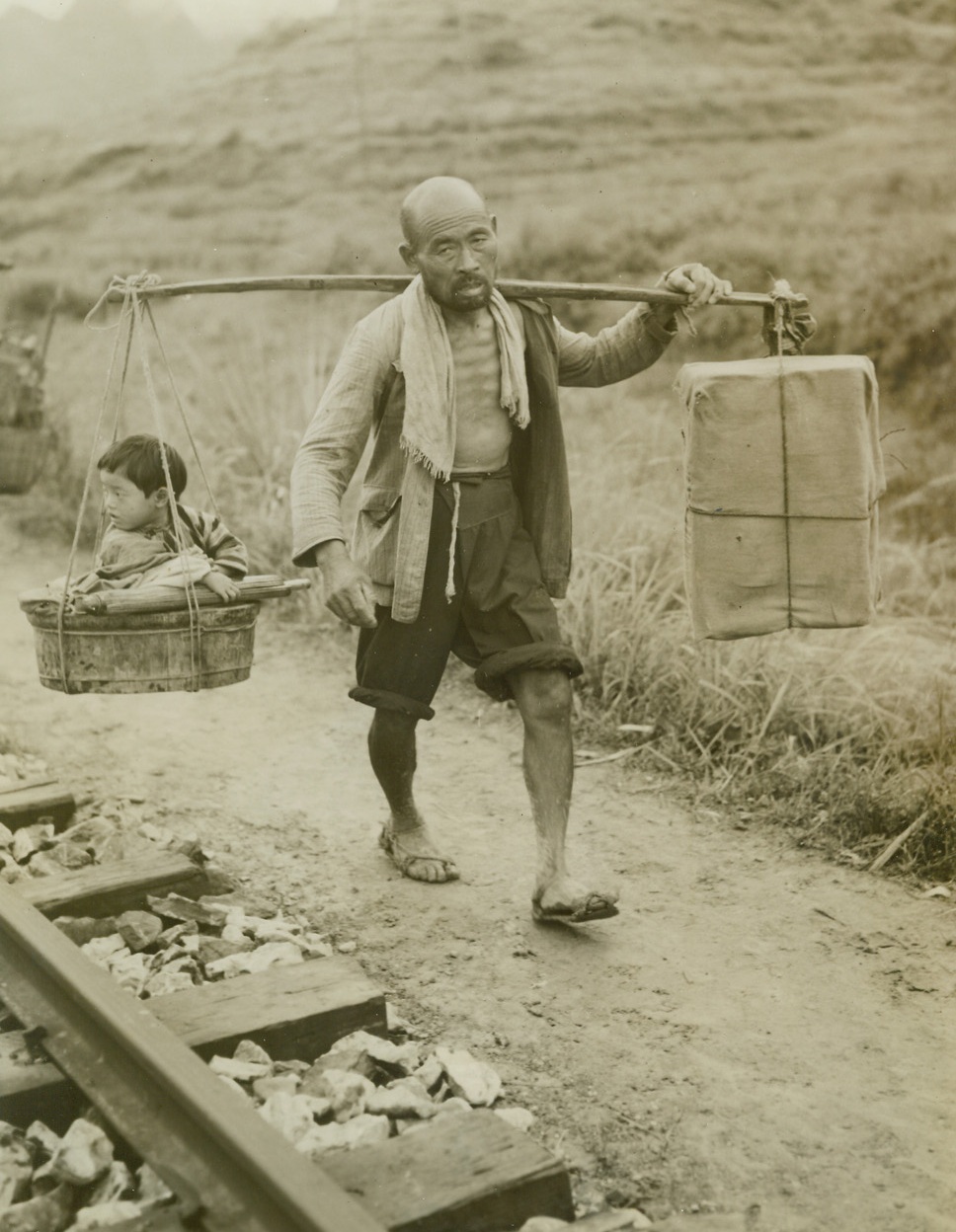
China’s Human Cargo, 11/10/1944. Eastern Front, China – Masses of humanity, united in one common purpose – flight for life—cram the railroads and highways leading from China’s Eastern front, as the instinct for self preservation sends them fleeing from Jap terror. Simple peasants they are, familiar with only the ways of simple folk like themselves, but they know the atrocities of the Japs, rather than live under the yoke or the rising sun, they choose to suffer hardship, and even death, to evade them. Trains leaving Liuchow are packed from the rails to the tops of the cars, and all available vehicles fill the highway as shown in this unusual and dramatic series of photos made by Frank Cancellare, ACME photographer for the War Picture Pool On the heels of the evacuees follow constantly the fear of the dread typhus and cholera epidemic but still they go onward. New York Bureau Weary from lack of rest and nourishment, this father bows under the yoke on which he carries his young son in a basket. He balances his burden with a box on the other end, which carries some of the family belongings. Photo by ACME photographer, Frank Cancellare, for the War Picture Pool. Credit – WP – (ACME);
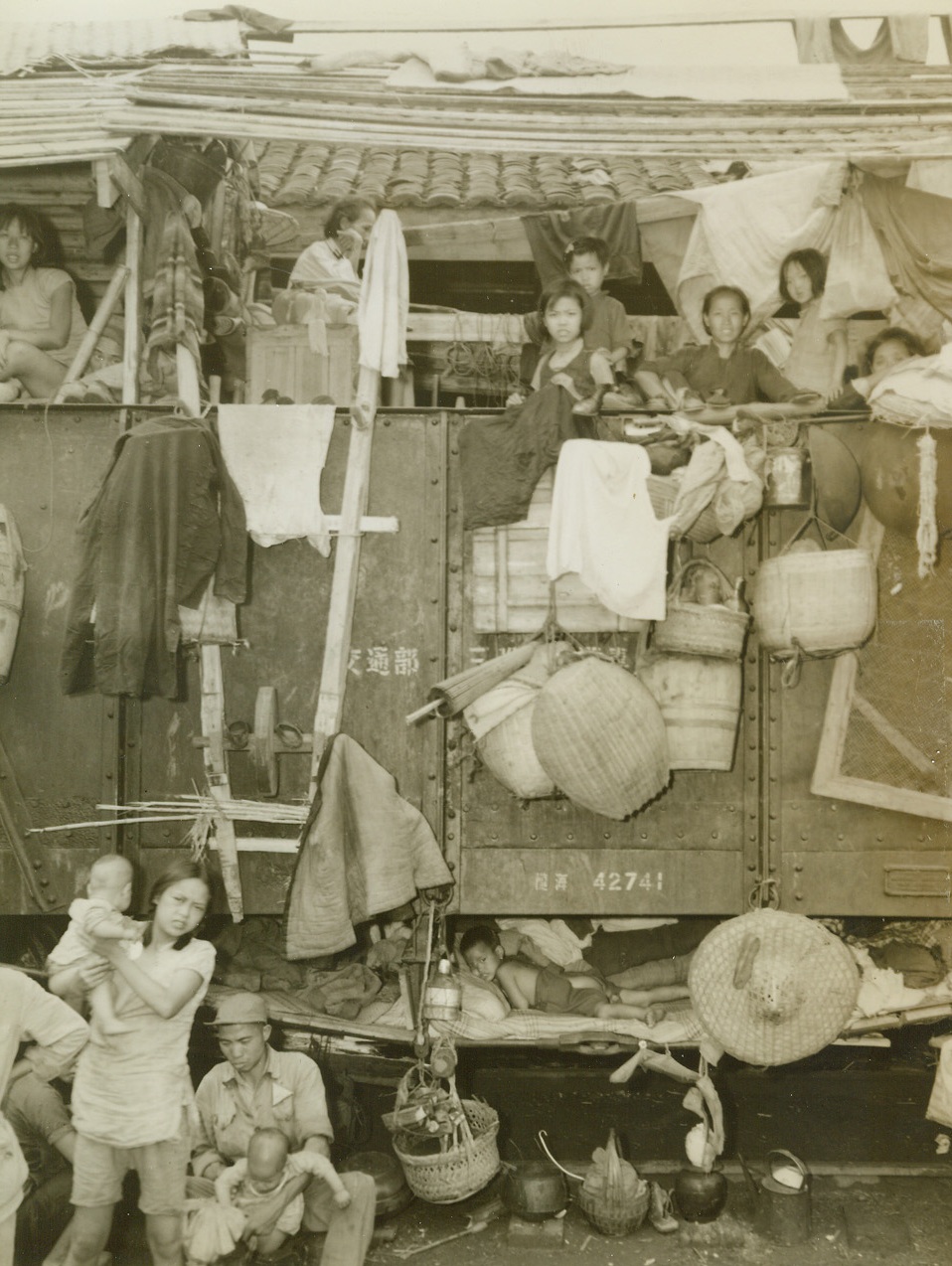
China’s Human Cargo, 11/10/1944. Eastern Front, China – Masses of humanity, united in one common purpose – flight for life—cram the railroads and highways leading from China’s Eastern front, as the instinct for self preservation sends them fleeing from Jap terror. Simple peasants they are, familiar with only the ways of simple folk like themselves, but they know the atrocities of the Japs, rather than live under the yoke or the rising sun, they choose to suffer hardship, and even death, to evade them. Trains leaving Liuchow are packed from the rails to the tops of the cars, and all available vehicles fill the highway as shown in this unusual and dramatic series of photos made by Frank Cancellare, ACME photographer for the War Picture Pool On the heels of the evacuees follow constantly the fear of the dread typhus and cholera epidemic but still they go onward. New York Bureau This freight car is packed inside and underneath with refugees. Most of their belongings are hung on the sides of the car, but blankets are kept out to shield them from the cold. Note the little boy underneath trying to get into a comfortable position to ride the rods. Photo by ACME photographer, Frank Cancellare, for the War Picture Pool. Credit-WP- (ACME);
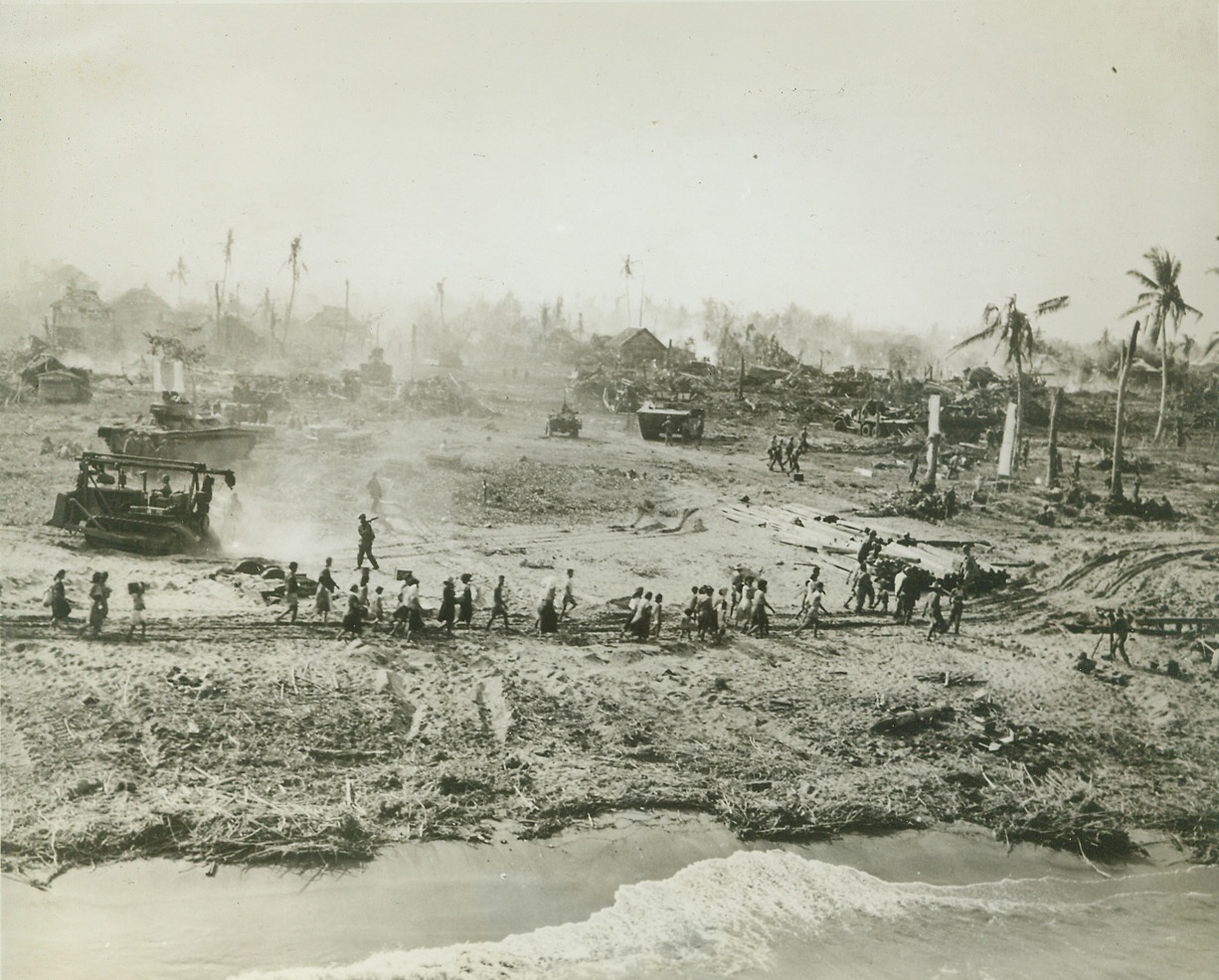
Natives Seek Safety With Yanks, 11/1/1944. PHILIPPINES -- On a smoldering beach of Leyte Island, Philippine natives follow American infantrymen to safety. Navy set up evacuation centers in safe areas where food and medical attention was given the frightened native people. Credit (Coast Guard Photo From ACME);
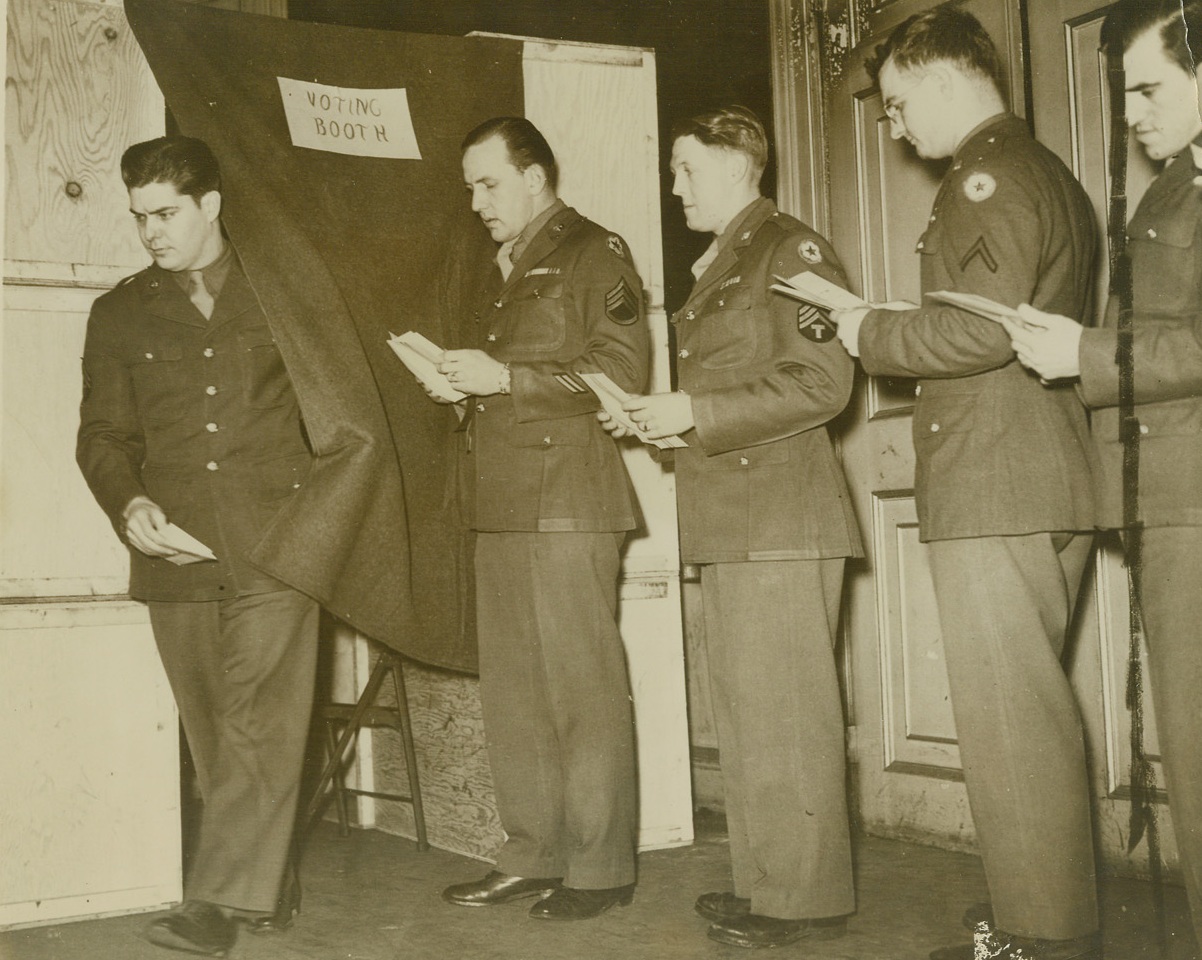
Yanks in Britain Cast Ballots, 11/2/1944. England—American soldiers line up to cast their ballots in voting booth at a polling station for GI’s in Britain. Yanks are recording their votes for the forthcoming Presidential election. Credit: ACME.;
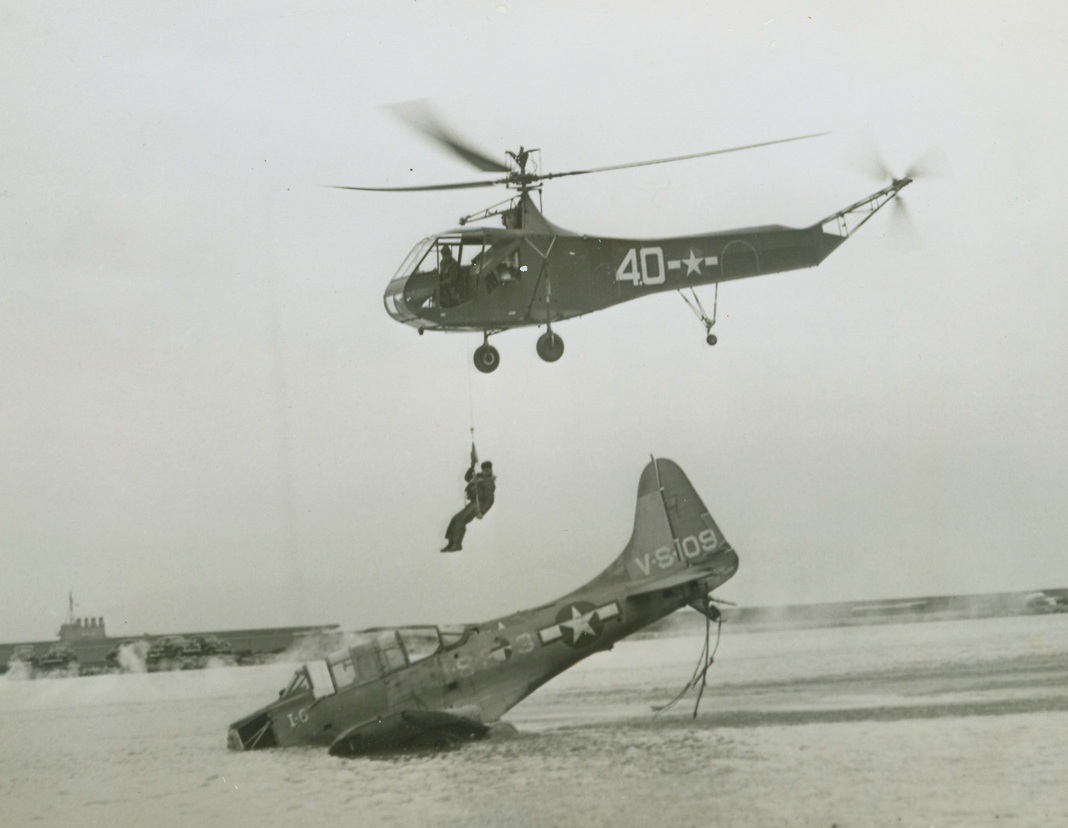
Lift to Life, 11/17/1944. Chicago—Michael Mastrone is lifted from simulated wreckage of a plane by a hydraulic hoist in a rescue demonstration which is part of the Navy Bond show being staged in Chicago. The Coast Guard helicopter is piloted by Lt. (j.g.) W.C. Bolton.Credit: ACME.;
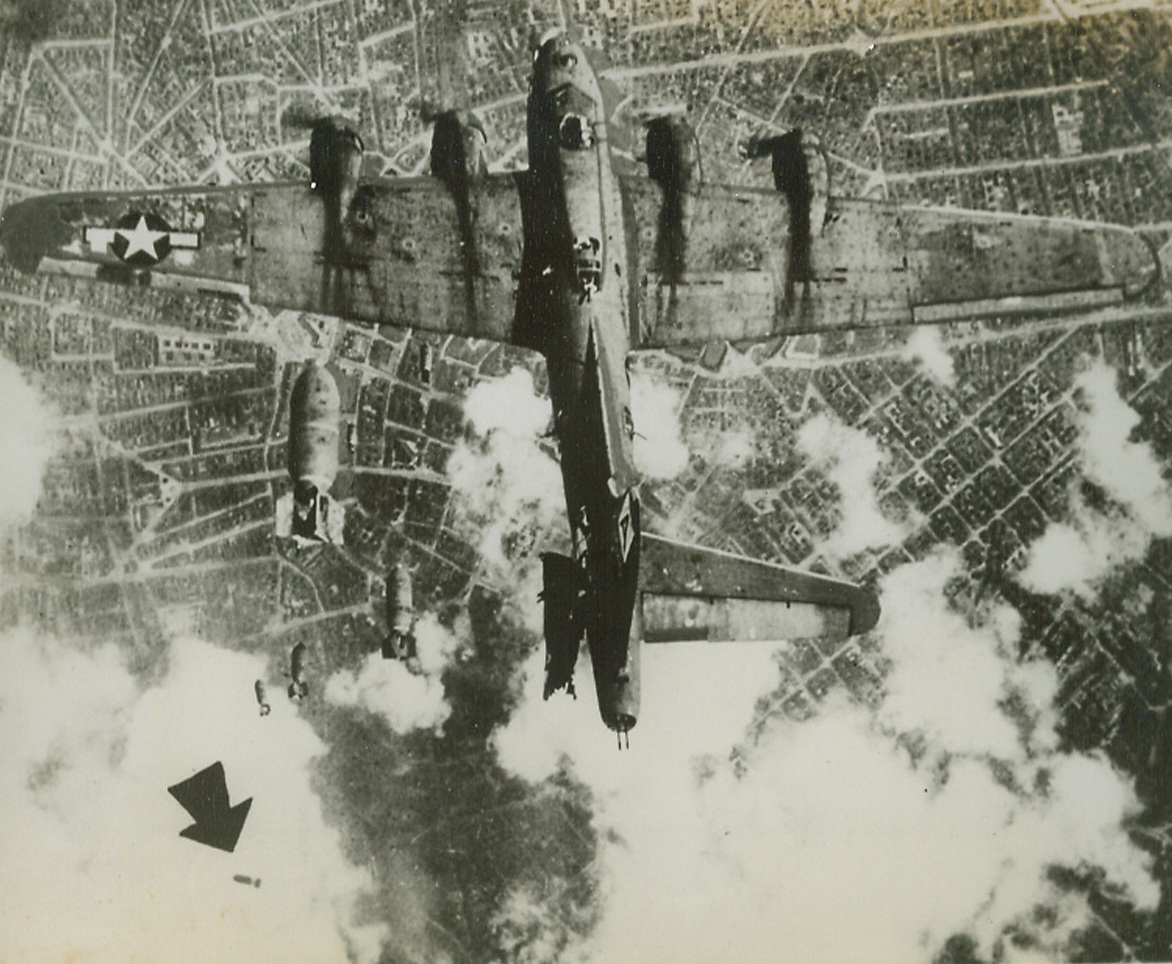
Completes Mission Despite Mishap, 11/3/1944. Seattle, Wash: Boeing Aircraft Co. of Seattle, has released this picture of a B-17 bomber over unidentified European city. The plane in close flight formation while laying precision pattern of explosives on target, has left stabilizer sheered off by bomb released from plane directly above. Bomb that struck plane veers away from target (arrow). Mishap did not prove fatal as mission was completed and ship arrived safely at home base.Credit: ACME.;
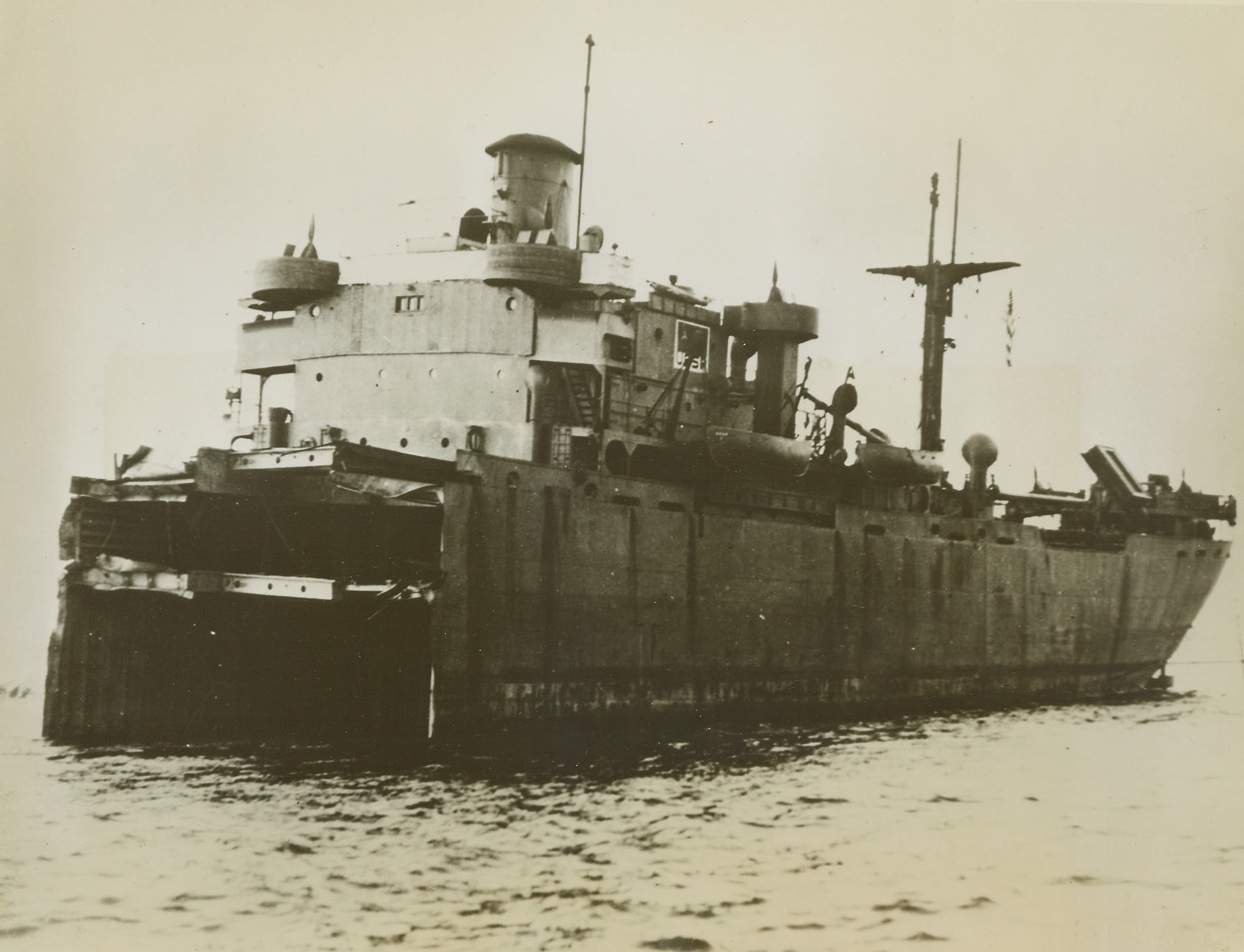
Unbowed, 11/10/1944. This is how the SS Valeri Chkalov appeared after the Liberty Ship was snapped in two by a violent Arctic storm. Only the after end and miships can be seen. The bow, miles away when this photo was taken, also was towed to a Canadian port where the parts were put together again. The vessel has since been restored to war service as the Alexander Baranoff, operated for the War Shipping Administration by the American Mail Line, Inc., Seattle, Wash.Credit: ACME.;
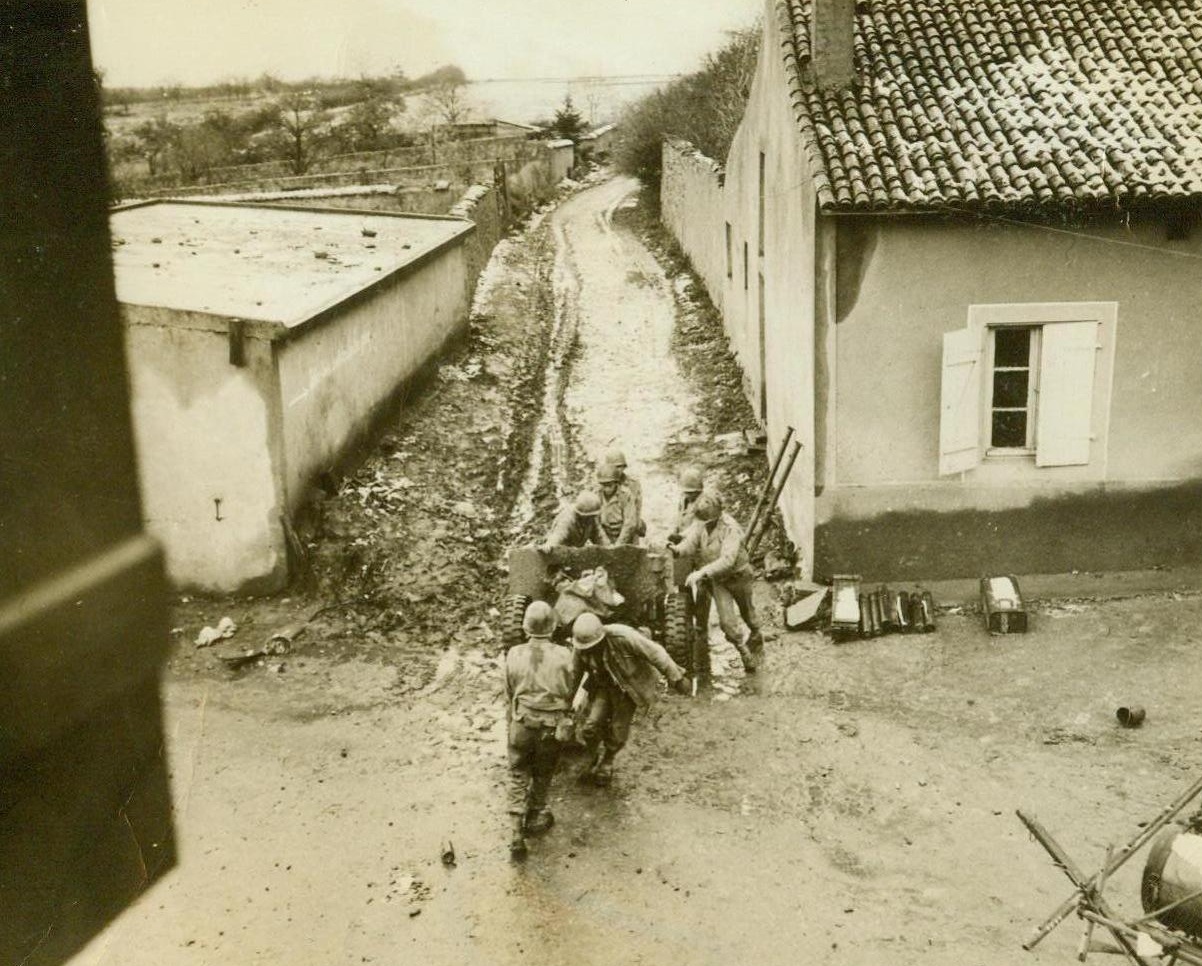
Slip and Slide To A New Position, 11/23/1944. Pouilly, France - Slipping and sliding as they push and pull at their 57mm anti-tank gun, these Third Army fighters find mud an unrelenting enemy as they move to a new position during the battle for Pouilly. Credit: ACME;
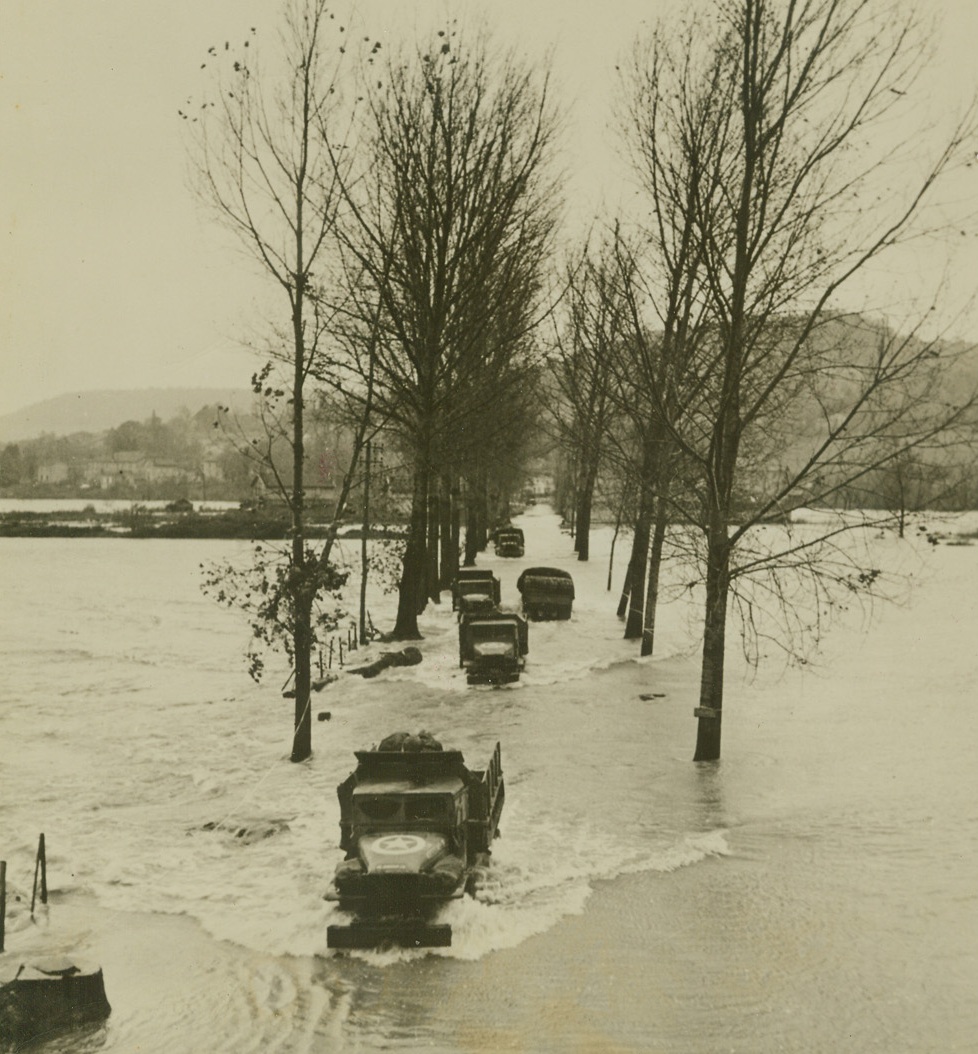
Misery at Metz, 11/17/1944. France – U.S. 3rd Army trucks make their way through engine deep flood waters cause by the winter rains in central France. This is a sample of the weather hazards in which General Patton has started his new offensive around Metz. Credit: ACME;
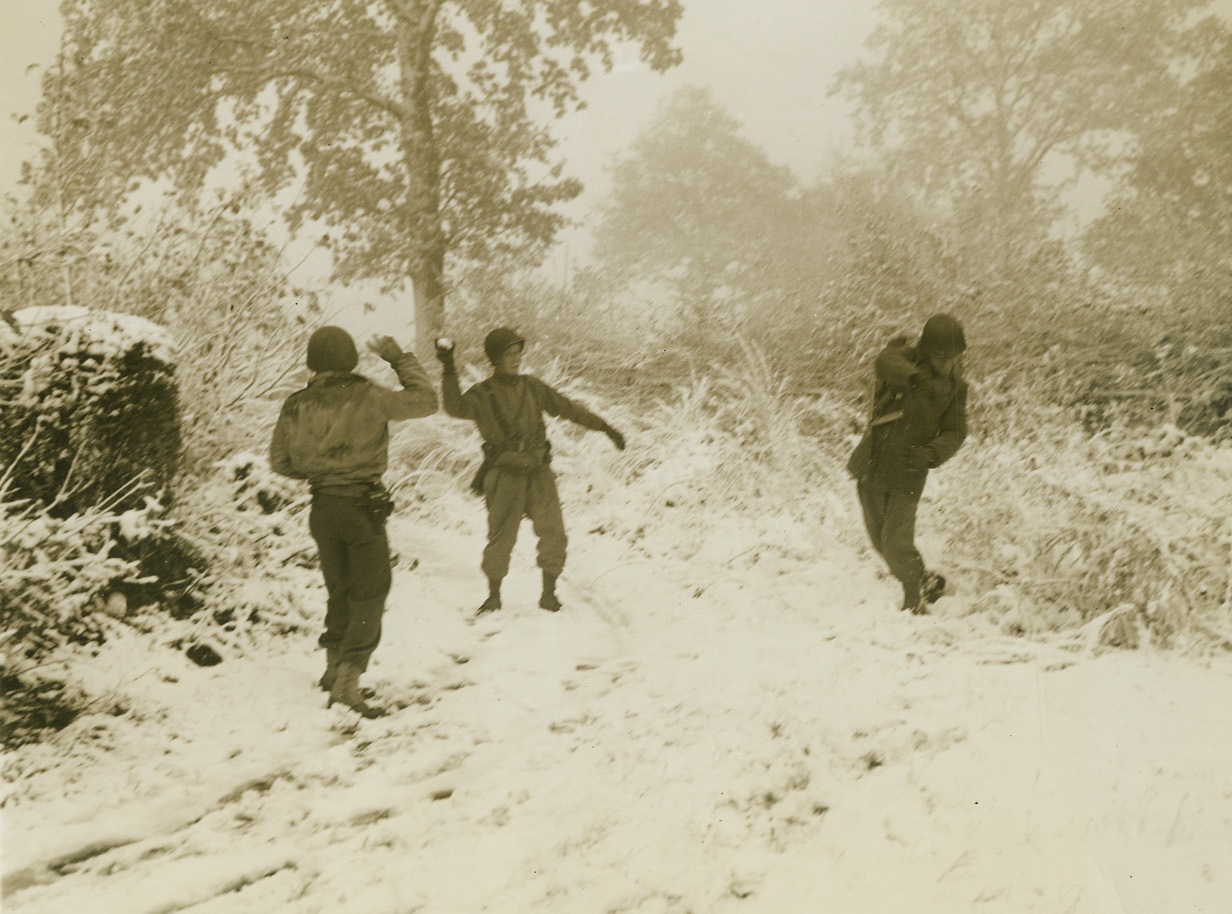
/Mock Battle on Real Battlefront, 11/18/1944. Germany – Laying down their lethal weapons for a time, these Yanks have a great deal more fun staging a snowball fight, after the fall of the first heavy snow that marked the beginning of winter for Americans with the 1st Army in Germany. Credit: ACME photo by Andrew Lopez, War Pool Correspondent;
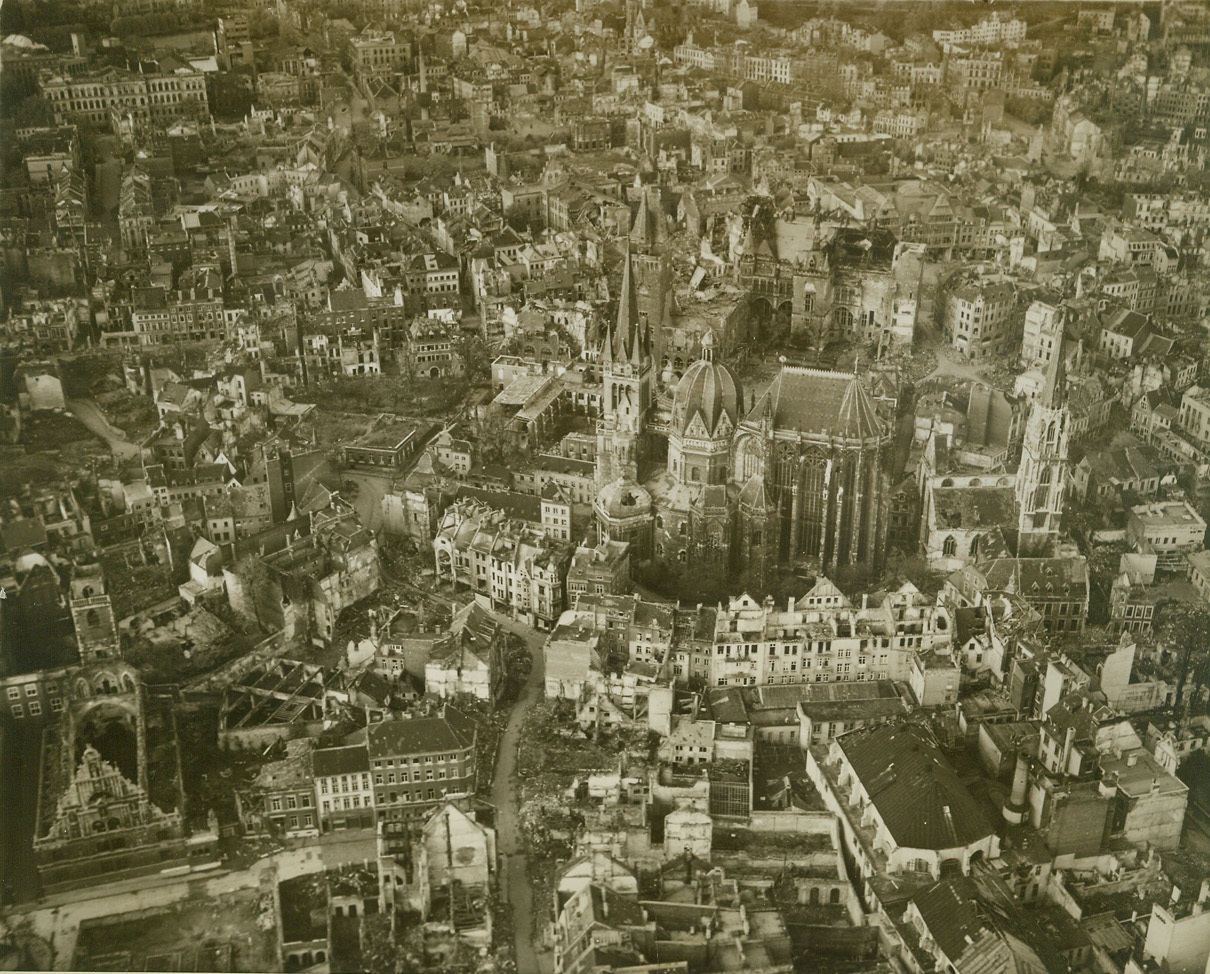
Aachen—A Dead City, 11/3/1944. GERMANY – The gutted homes and ruins of Aachen are evident in this aerial photo of the German city taken after its fall. Aachen Cathedral, burial place of Charlemagne, is the only building which stands almost undamaged amid the ruins of the city. Photo by Acme photographer, Andrew Lopez, for the War Picture Pool. Credit-WP-(Acme);
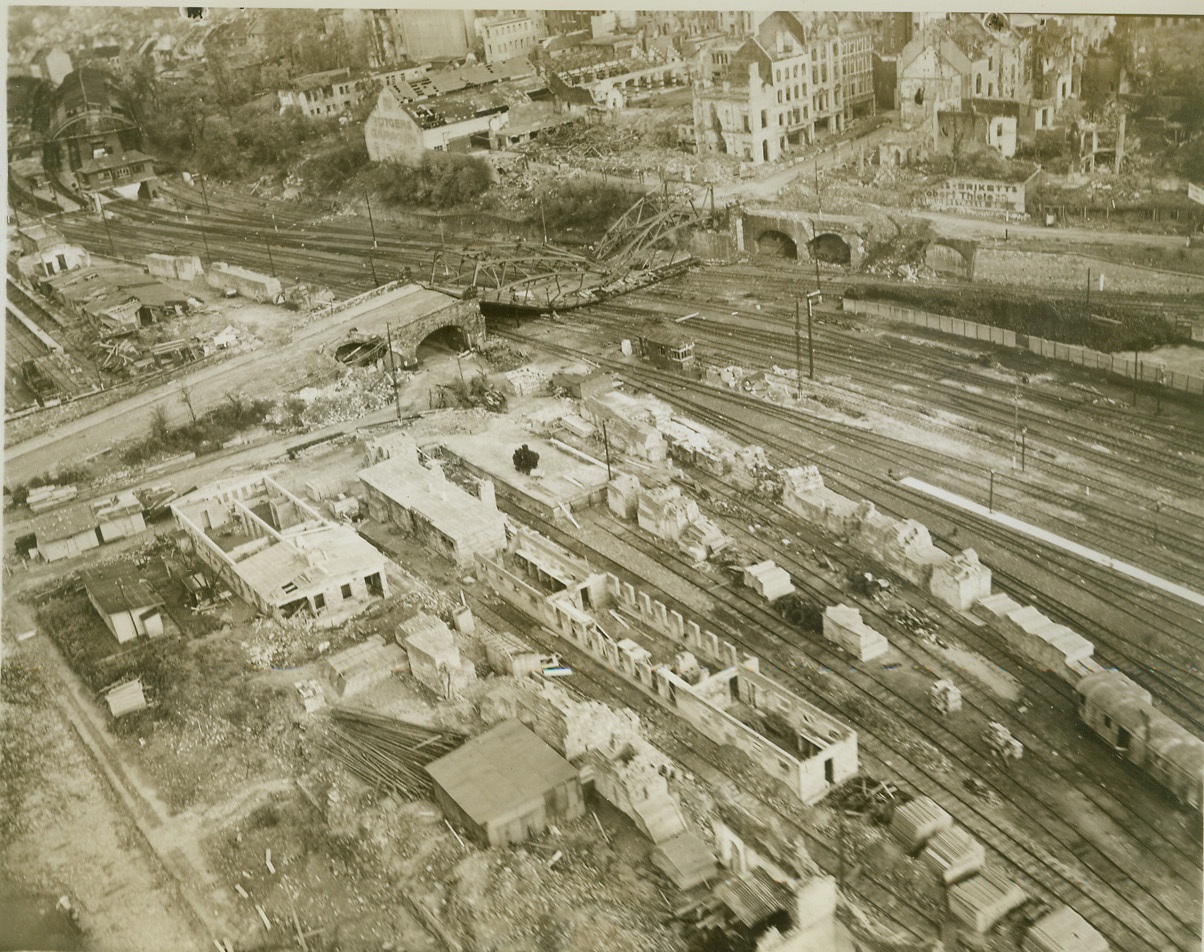
Allied Bombs Smashed Aachen Rails, 11/3/1944. GERMANY -- This striking aerial photo, taken after the fall of Aachen, shows the devastating effect of Allied bombing in the area near the railway station and marshalling yards of the key German city. The road bridge over the railway has been demolished by direct hits. Warehouses, rolling-stock and supplies in the sidings have been wrecked by accurately aimed bombs. Photo by Acme photographer, Andrew Lopez, for the War Picture Pool. Credit-WP-ACME;
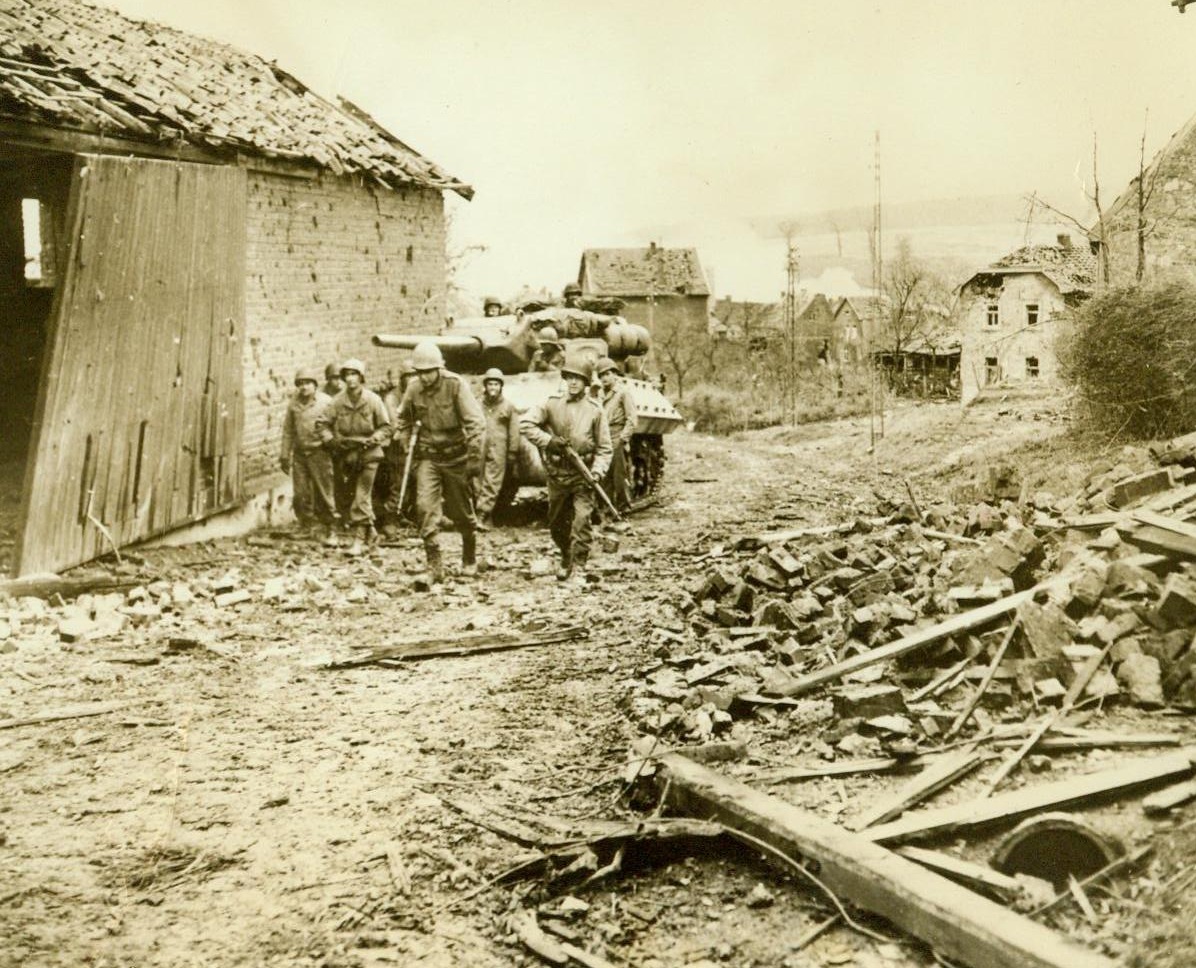
Advance In Gressenich, 11/23/1944. Gressenich, German – Trudging before a tank, Yank fighting men toil up a hill in shattered Gressenich, the first town to fall before the U.S. First Army’s new drive 11/23/44 (ACME);
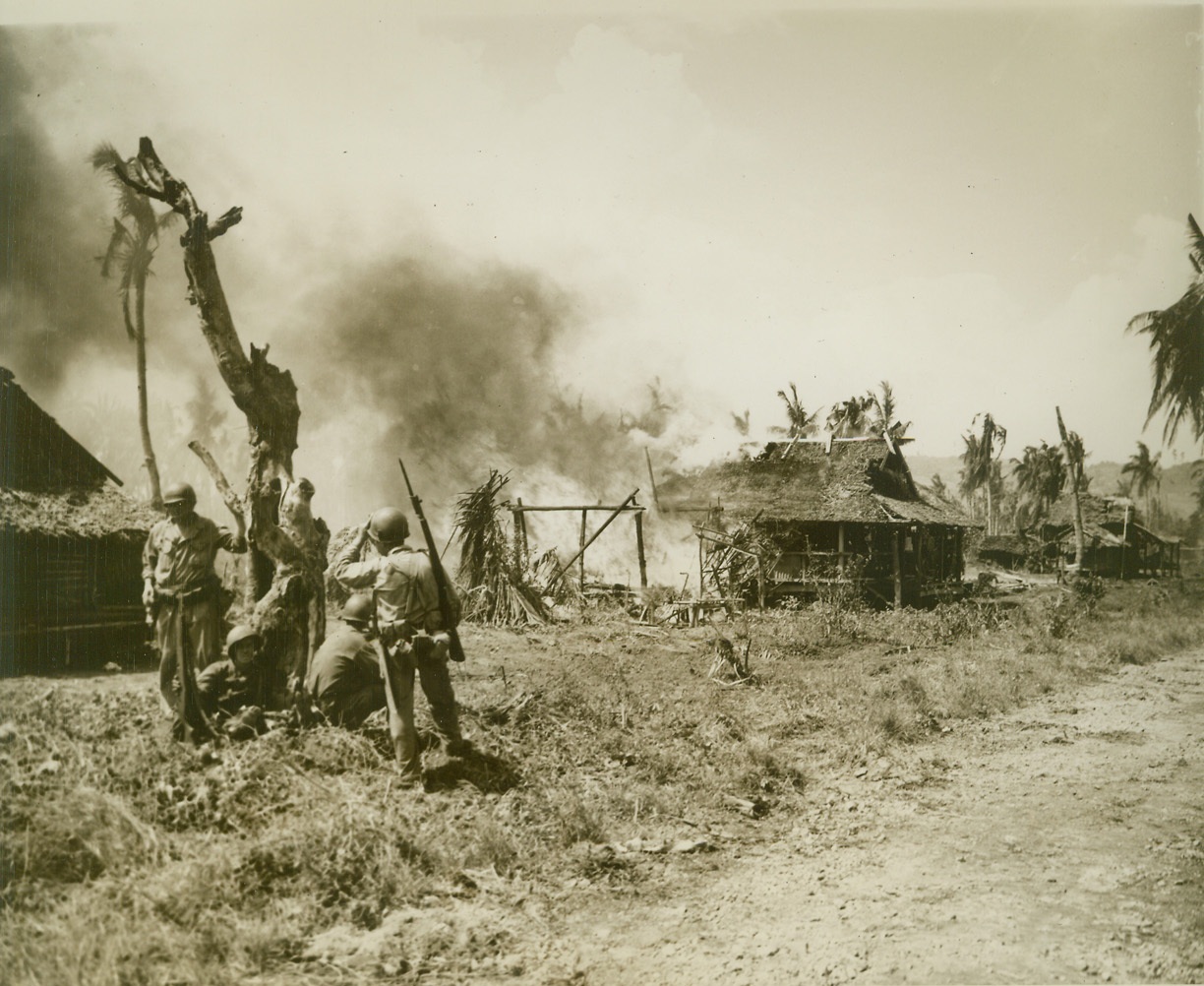
Jap Fire Razes Philippine Village, 11/1/1944. Leyte, Philippines—Infantrymen keep watch beside a gaunt, scarred tree in the flaming village of San Jose on Leyte. The tiny village caught fire as Japs sent their counter-fire toward invading Yank forces. Photo by ACME photographer Stanley Troutman for the war picture pool. Credit: ACME.;
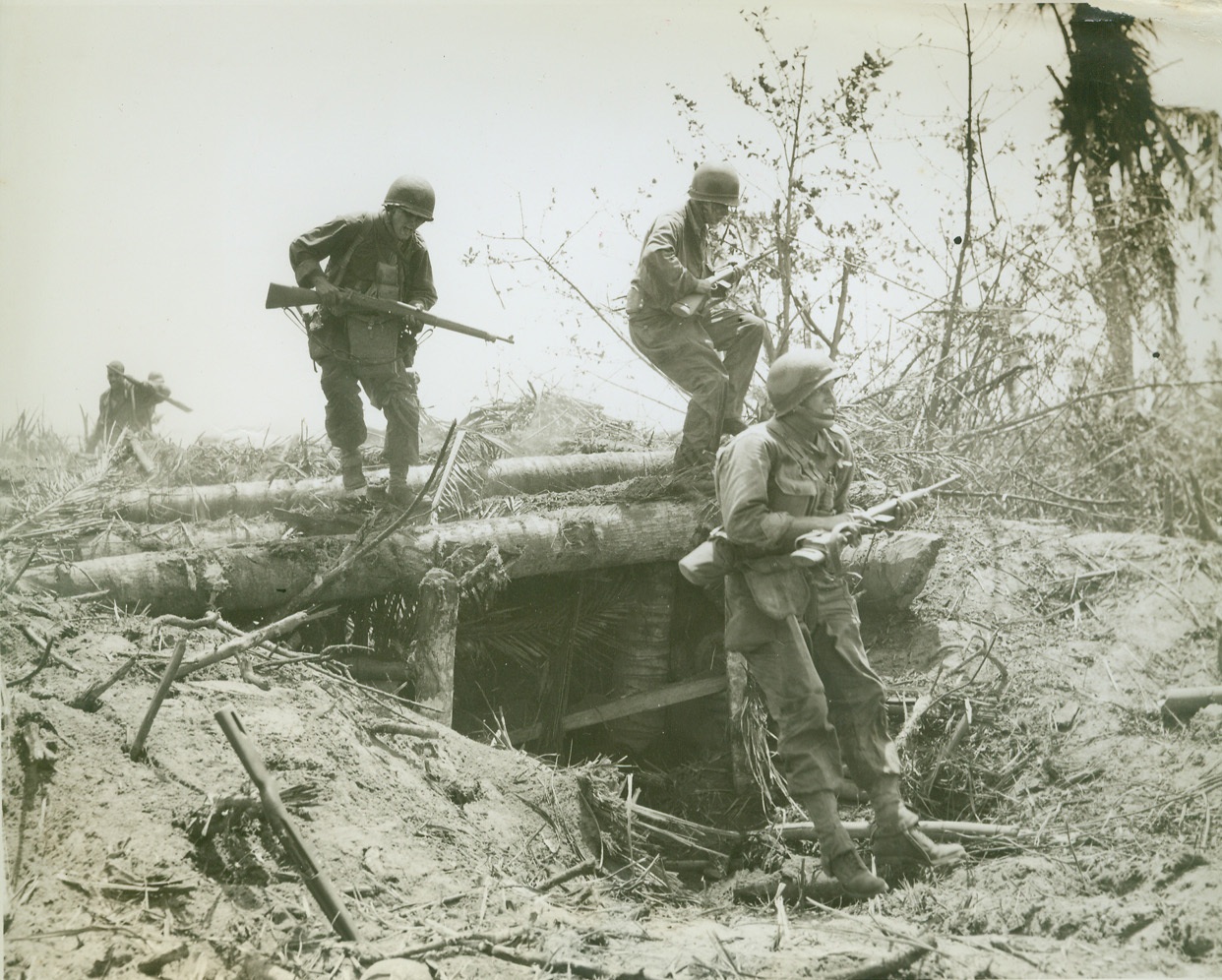
Speedy Jap-Hunters, 11/1/1944. Leyte, Philippines—Fast-stepping 96th division infantrymen speedily put ground between themselves and the landing beaches as they hurry after the Japs in the initial hours of the Leyte invasion. Photo by ACME photographer Stanley Troutman for the war picture pool. Credit: ACME.;
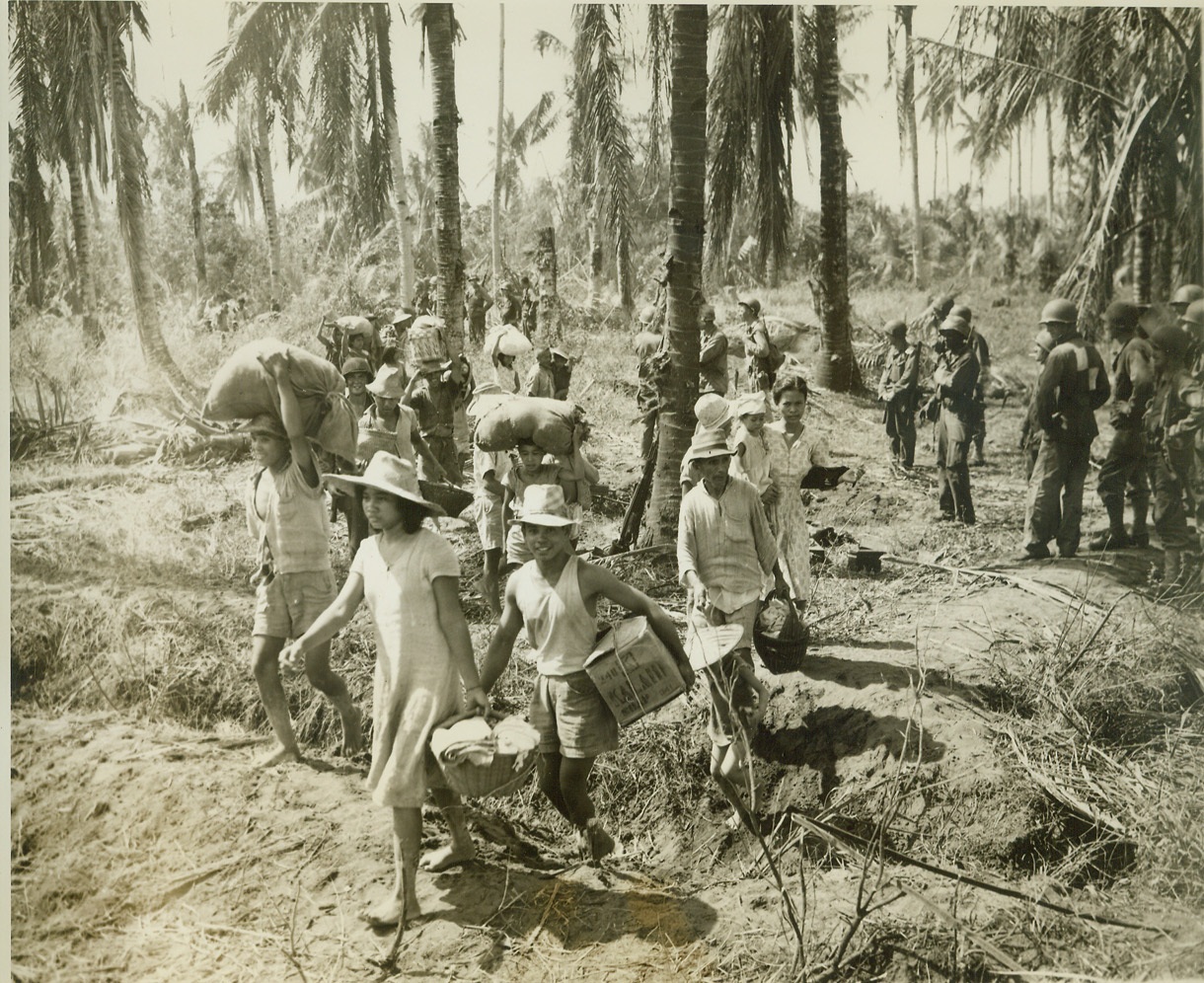
Natives Seek Safety, 11/1/1944. Leyte, Philippines—Each one carrying a few salvaged possessions, Filipinos stream through American lines on Leyte, headed for the comparative safety of the invasion beaches. Photo by ACME photographer Stanley Troutman, for the war picture pool. Credit: ACME.;
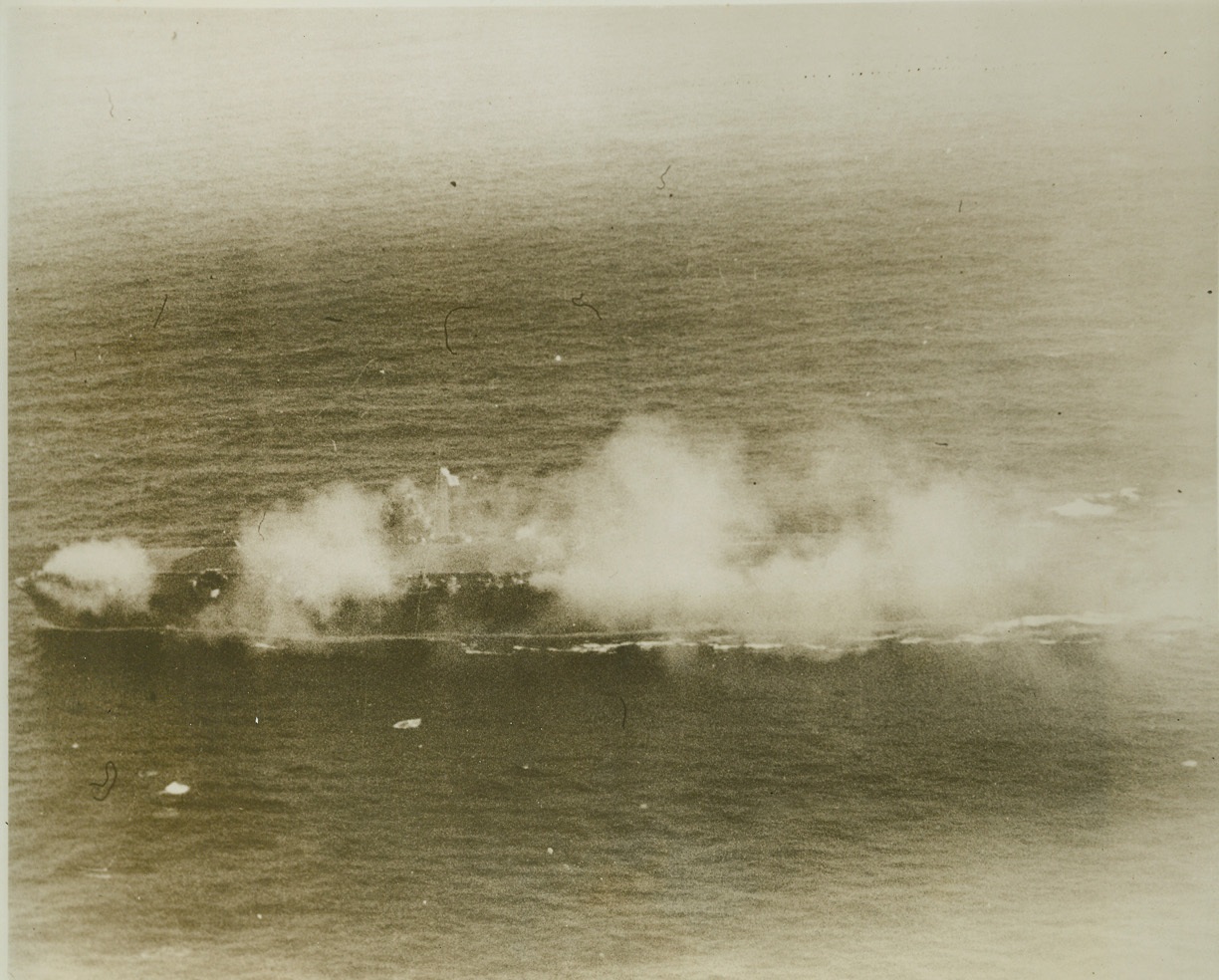
The Bitter End, 11/1/1944. Philippines—Aflame from stem to stern, this light carrier of the Jap Navy’s Chitose glass lies dead in the waters off Luzon, Philippines. The ill-fated vessel was attacked by carrier forces of the U.S. Pacific fleet. Credit: U.S.S. Navy photo from ACME.;





 Trash & Recycling
Trash & Recycling
 Online Payments
Online Payments
 City Documents
City Documents
 Parks
Parks
 Traffic Court
Traffic Court
 CITY PARKS
CITY PARKS
 Outdoor Recreation
Outdoor Recreation
 Volunteer
Volunteer
 Home
Home TRANSLATE
TRANSLATE
